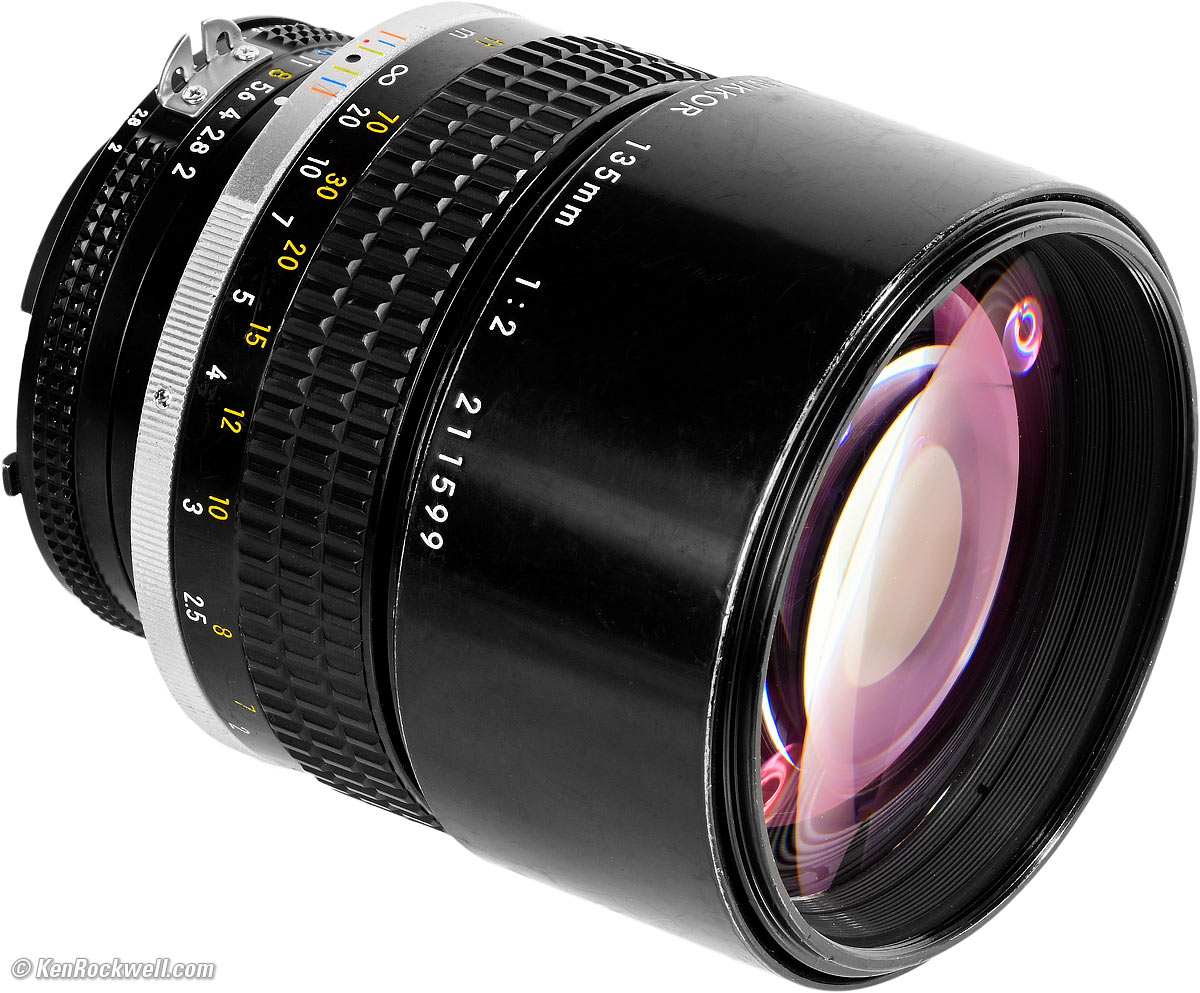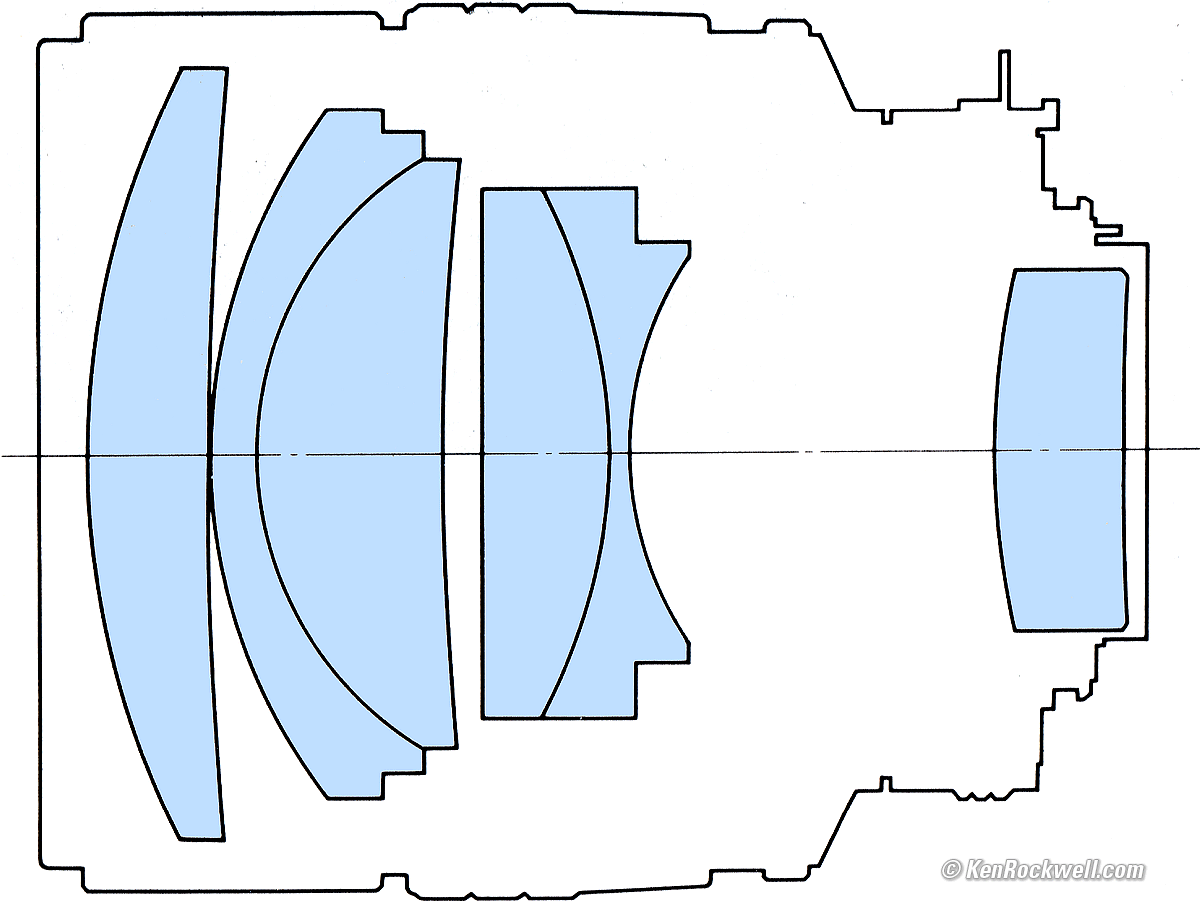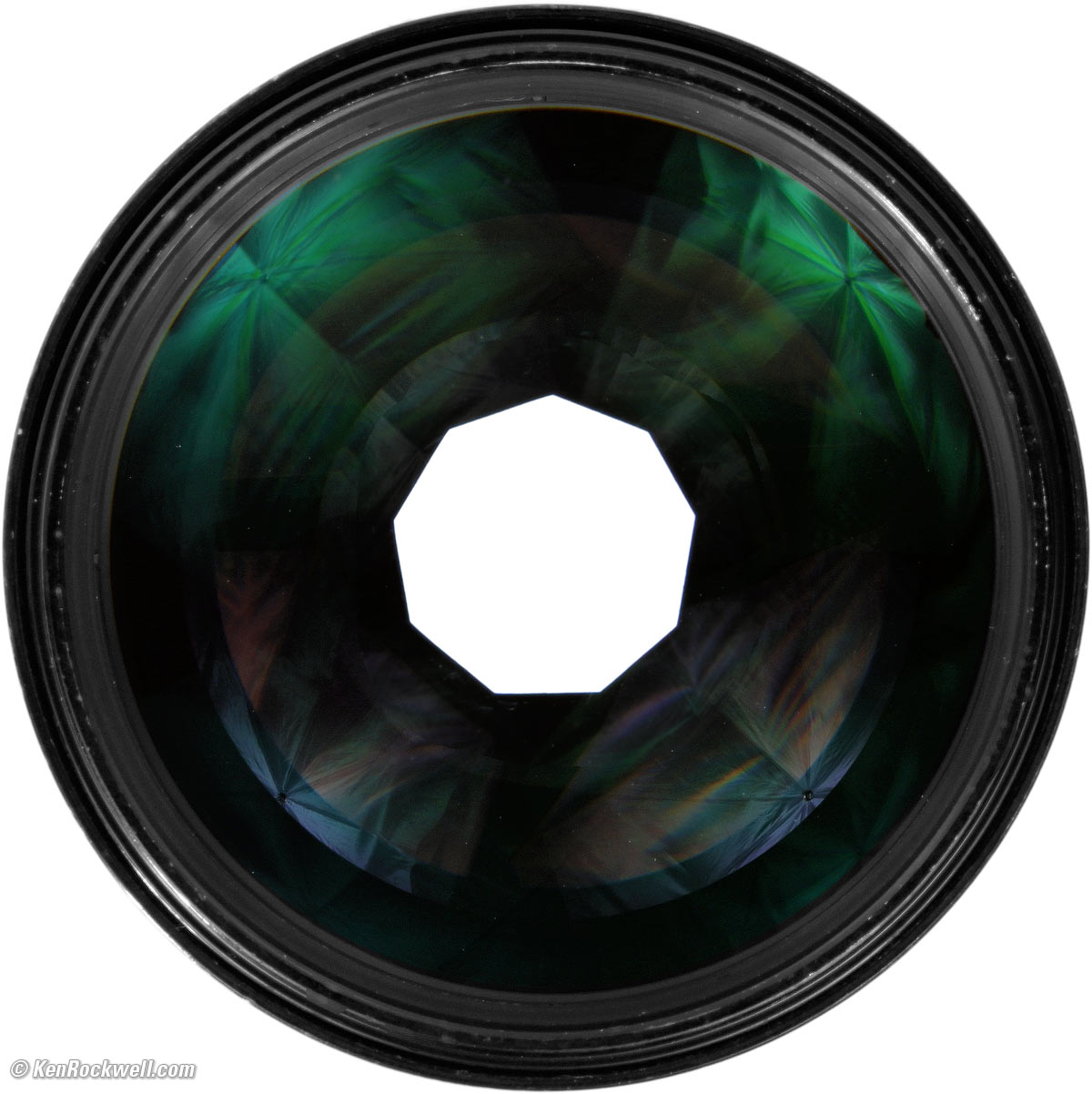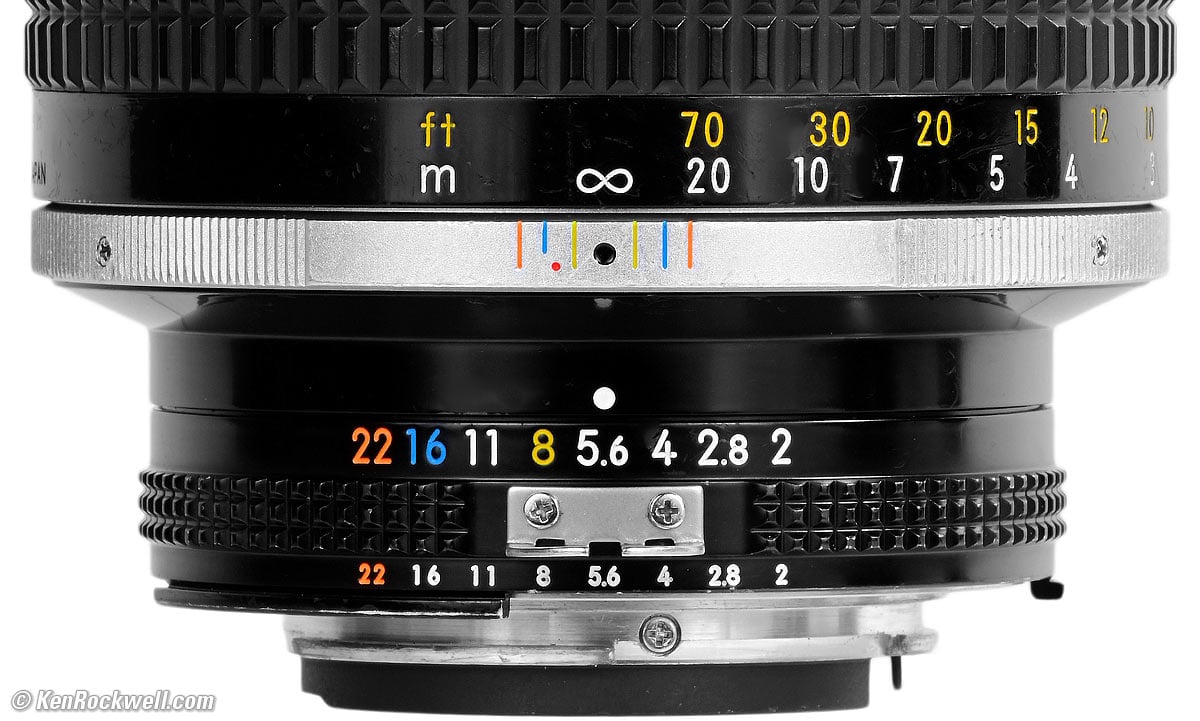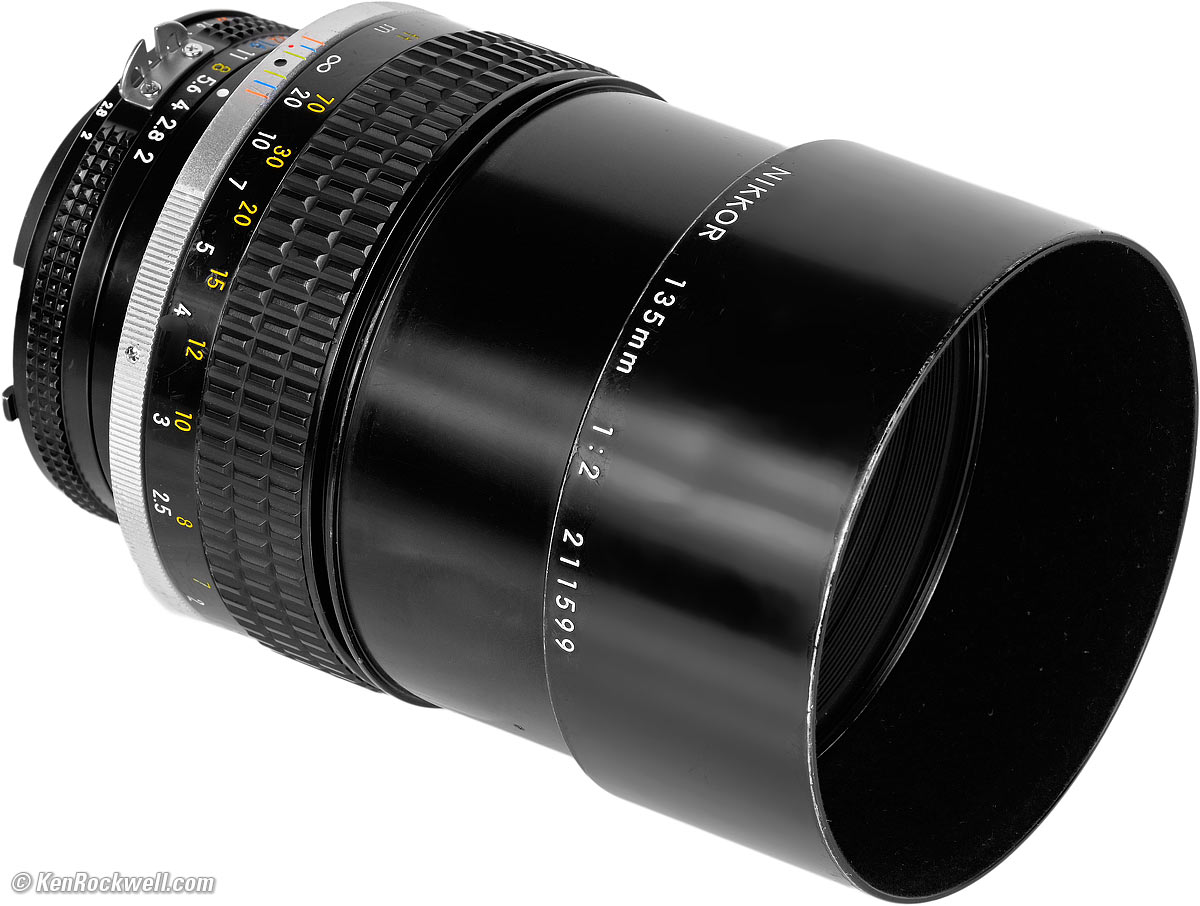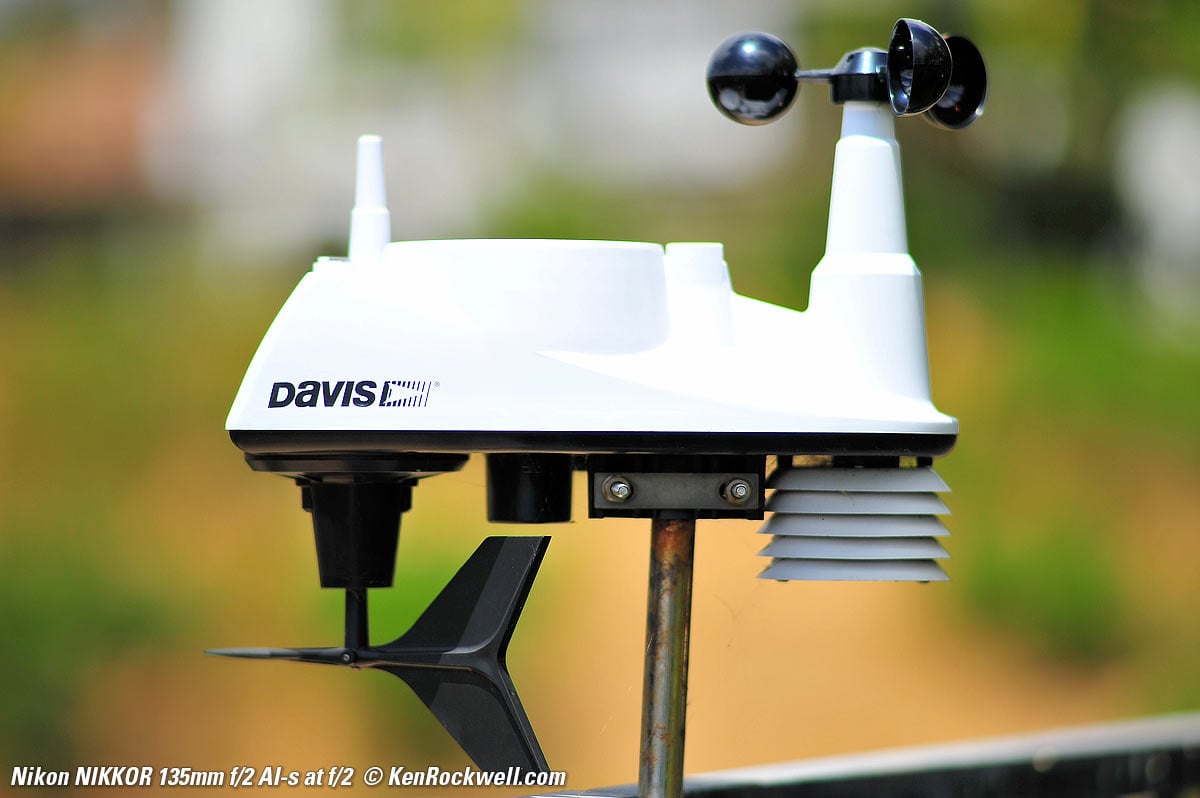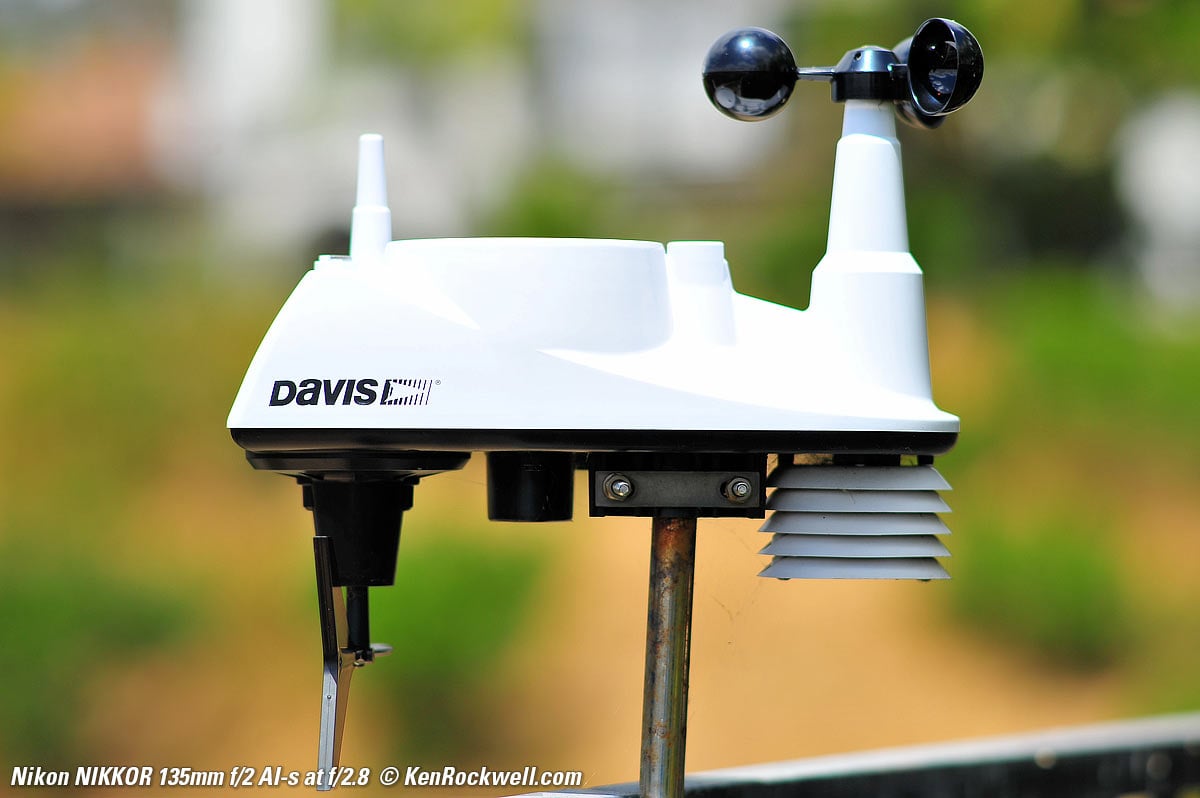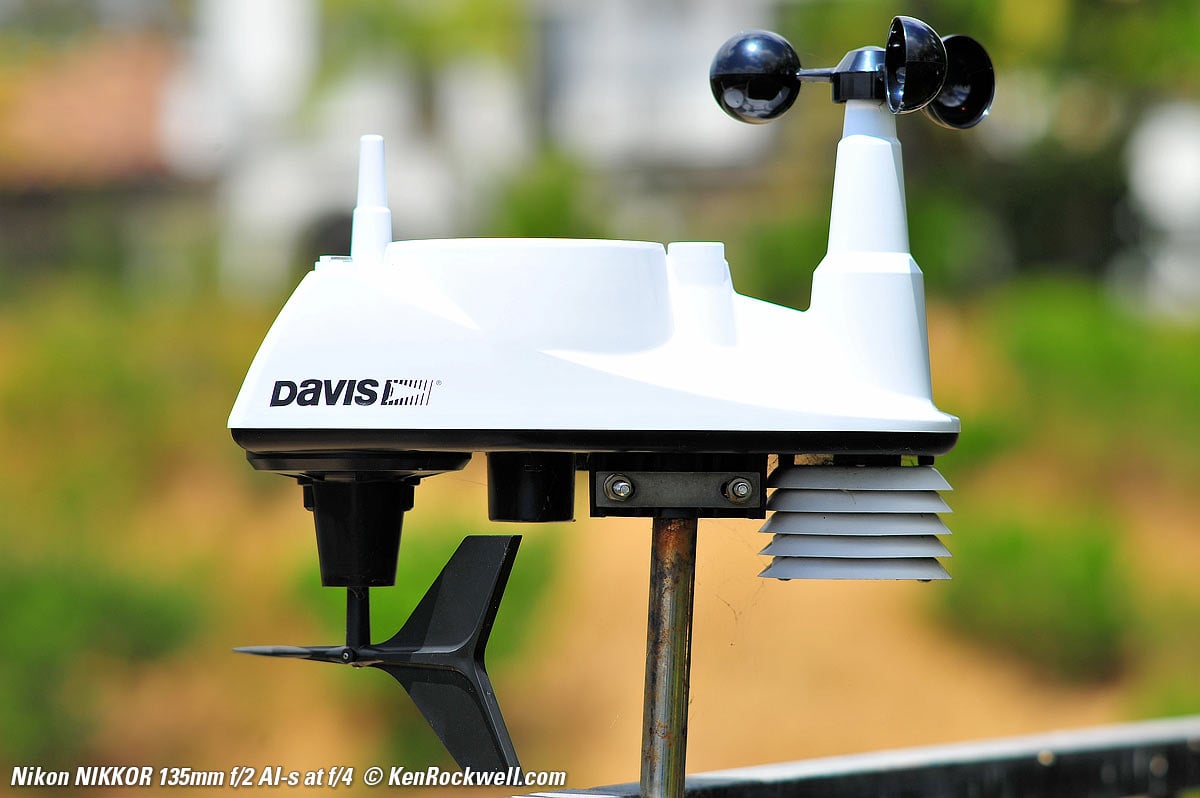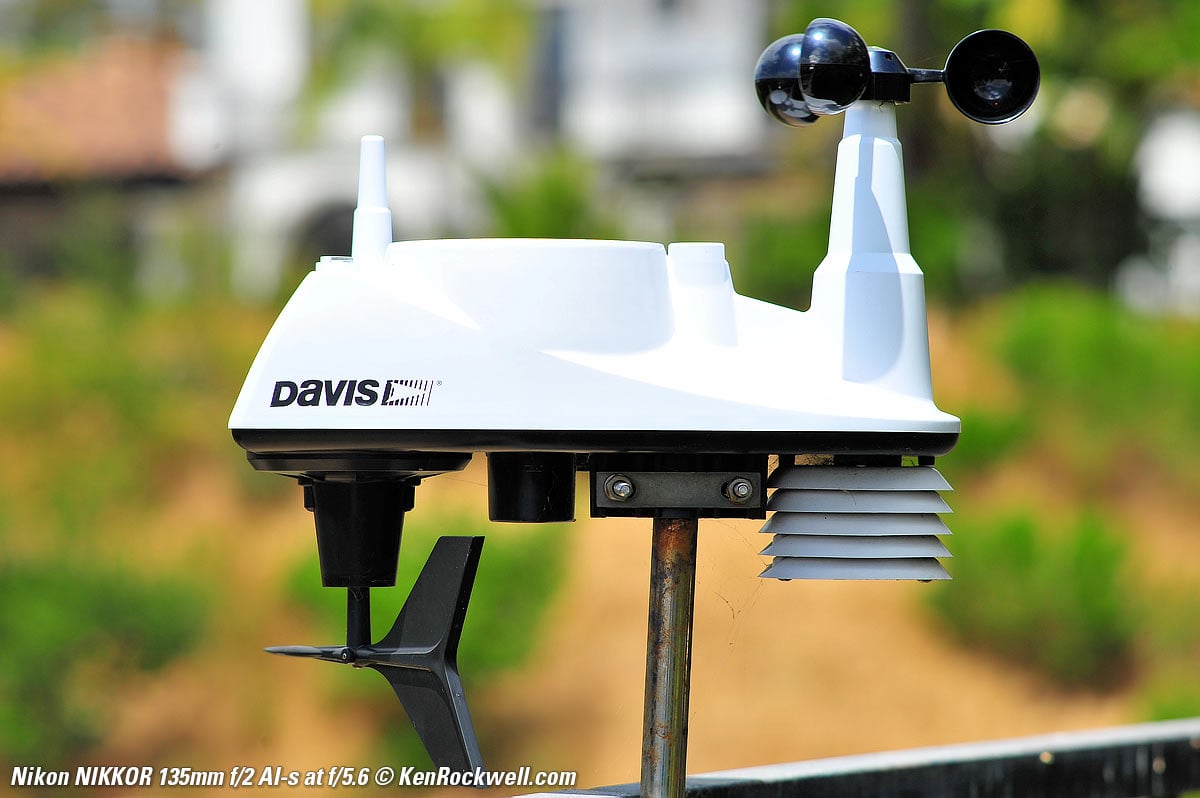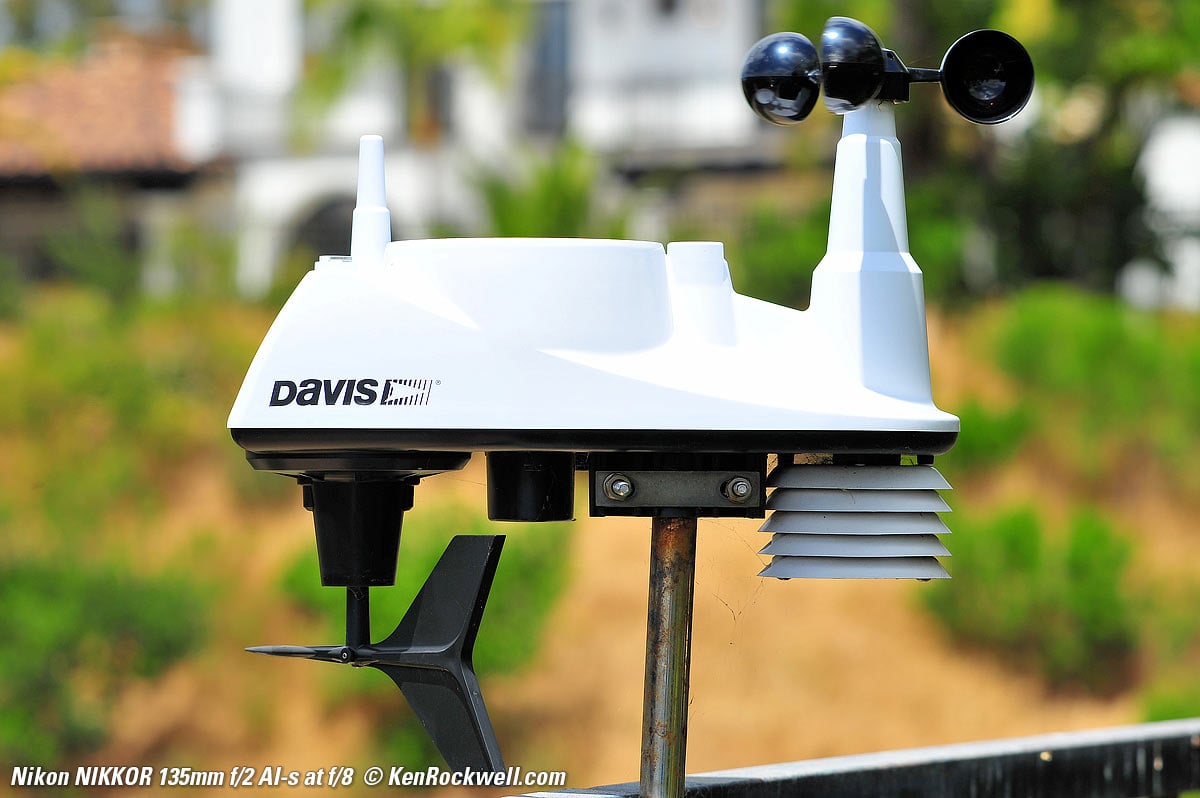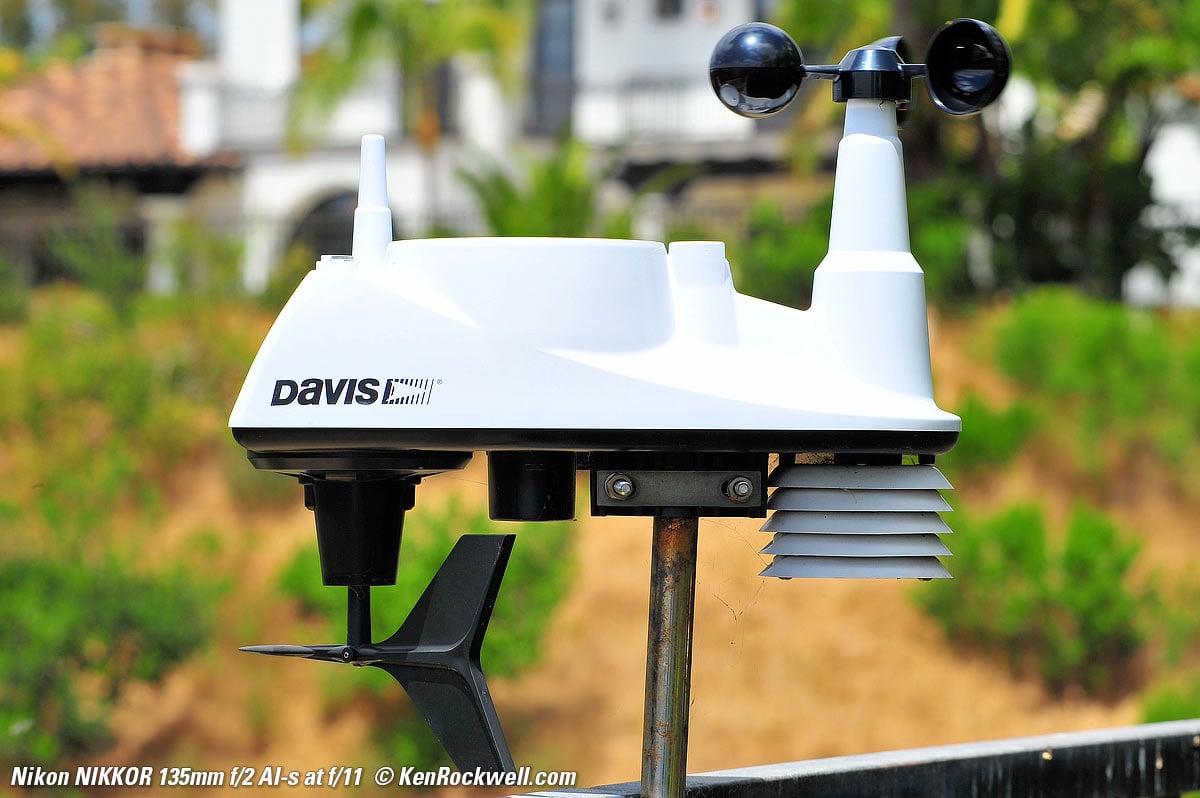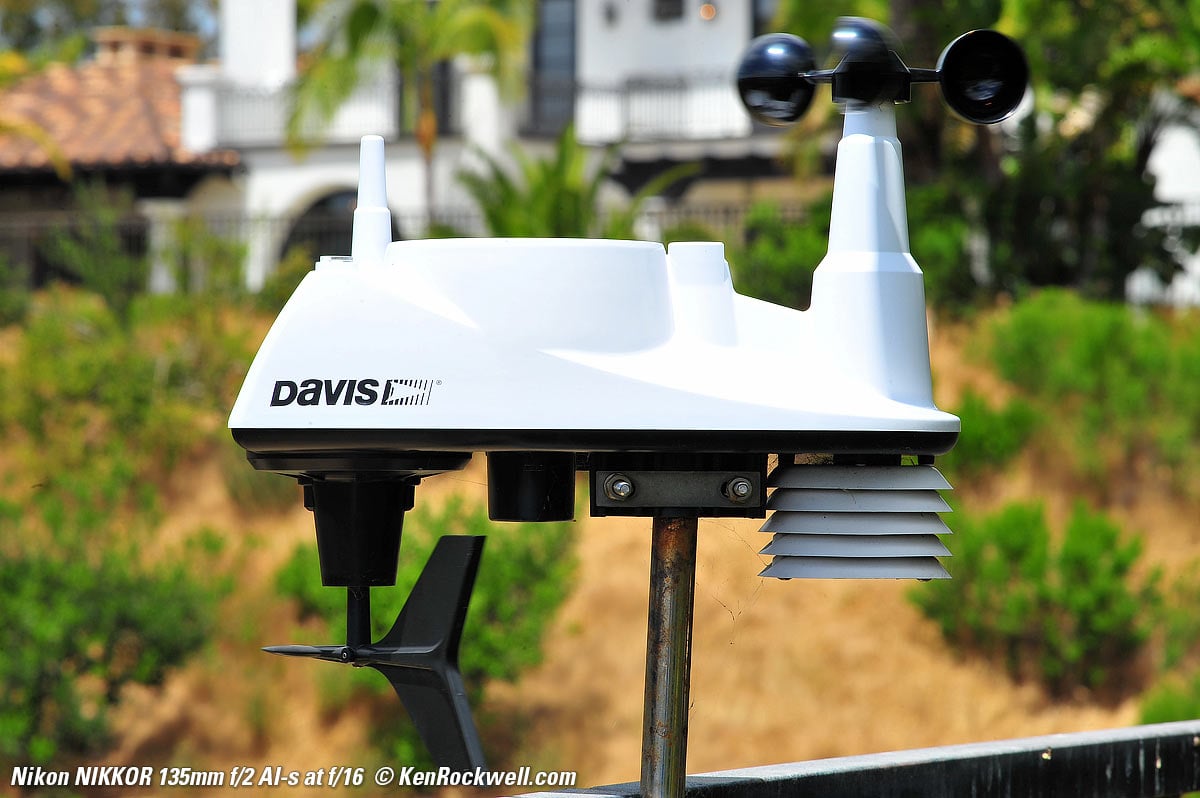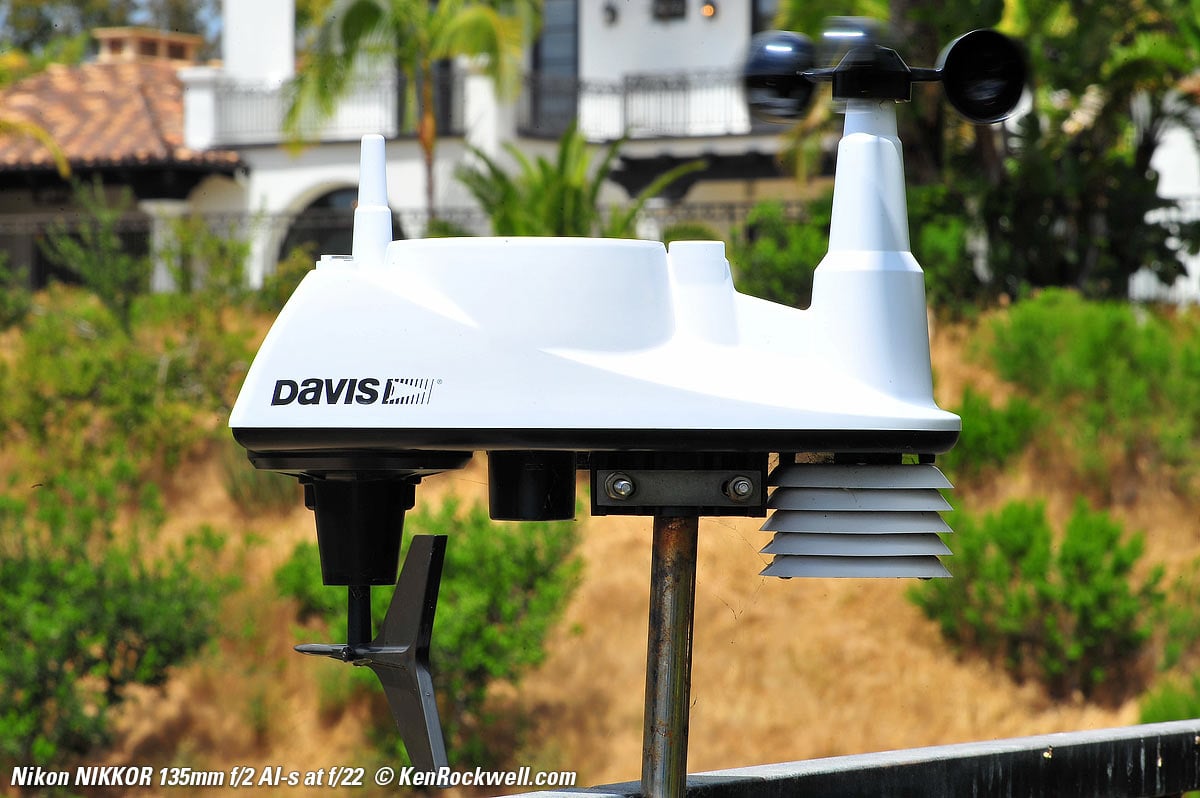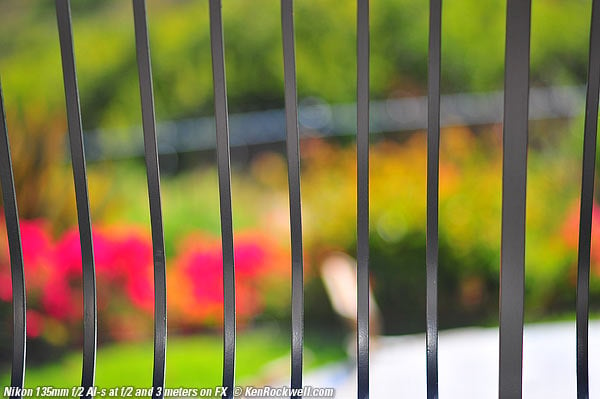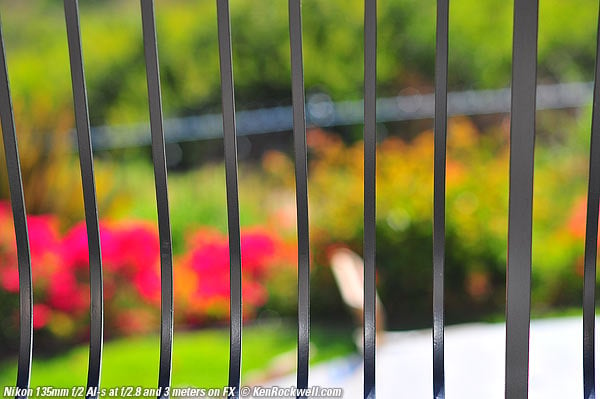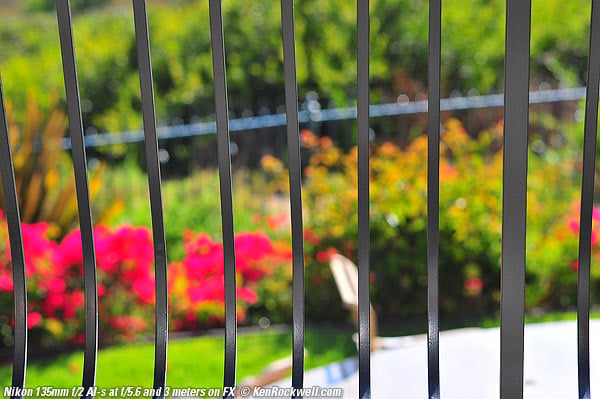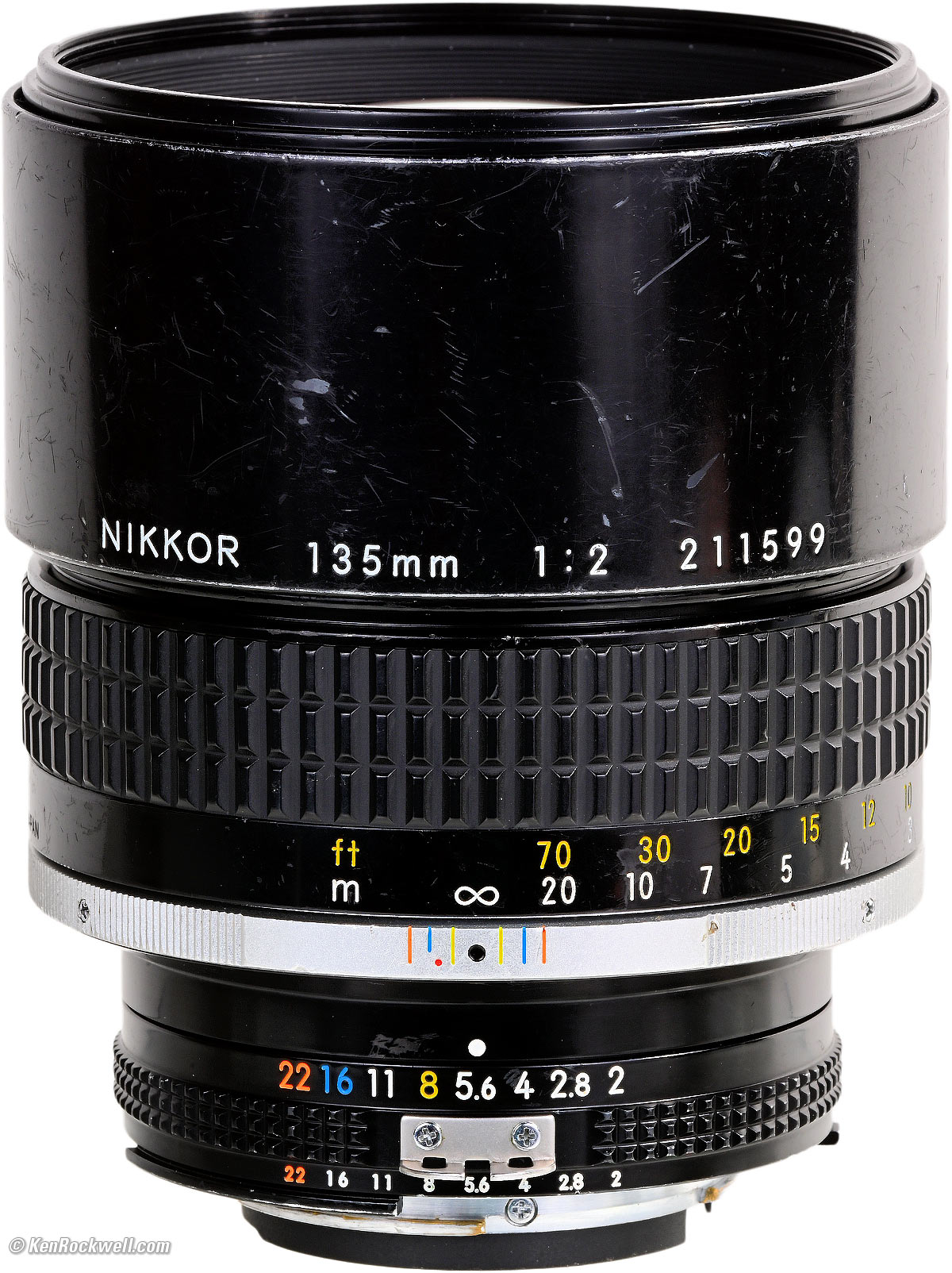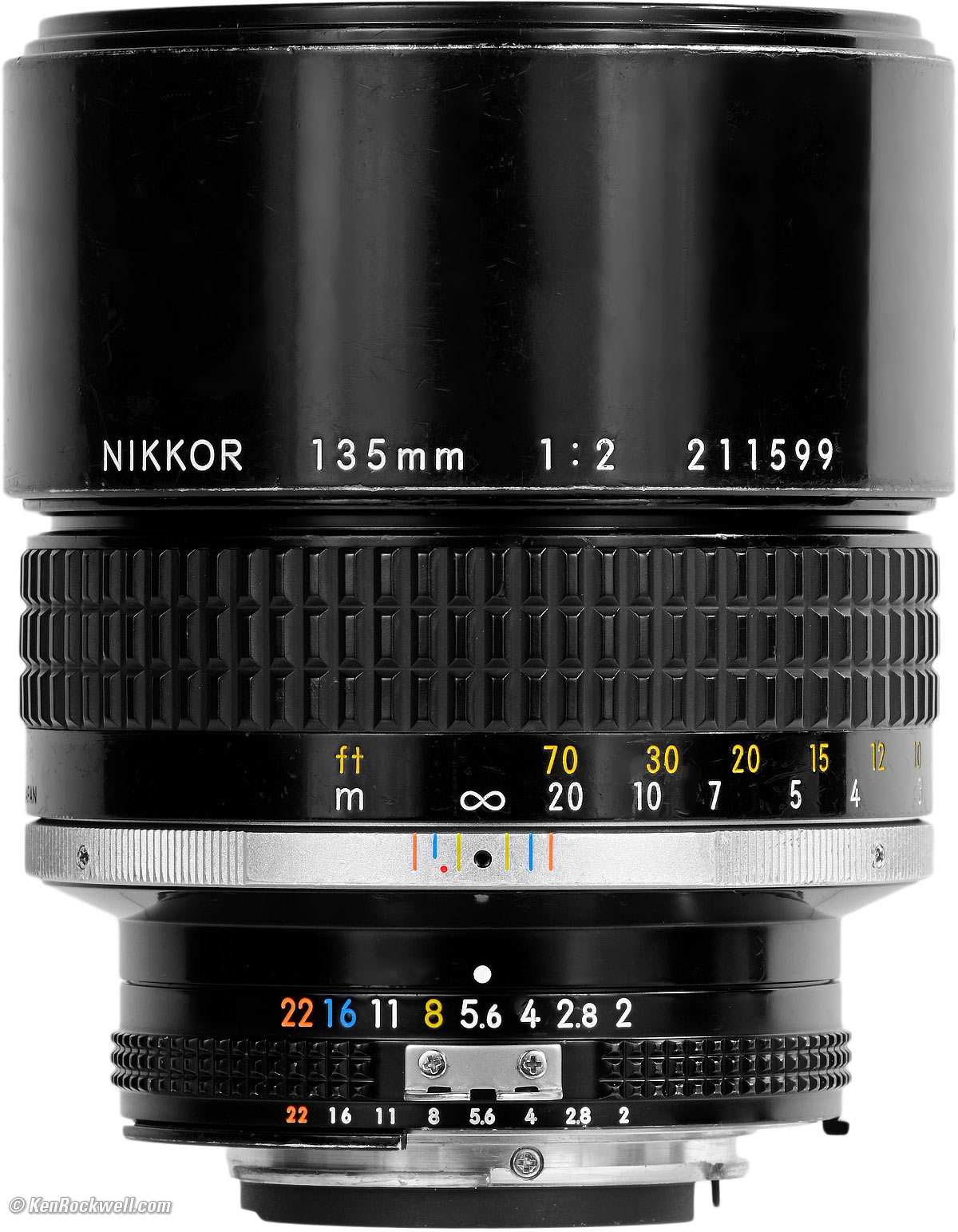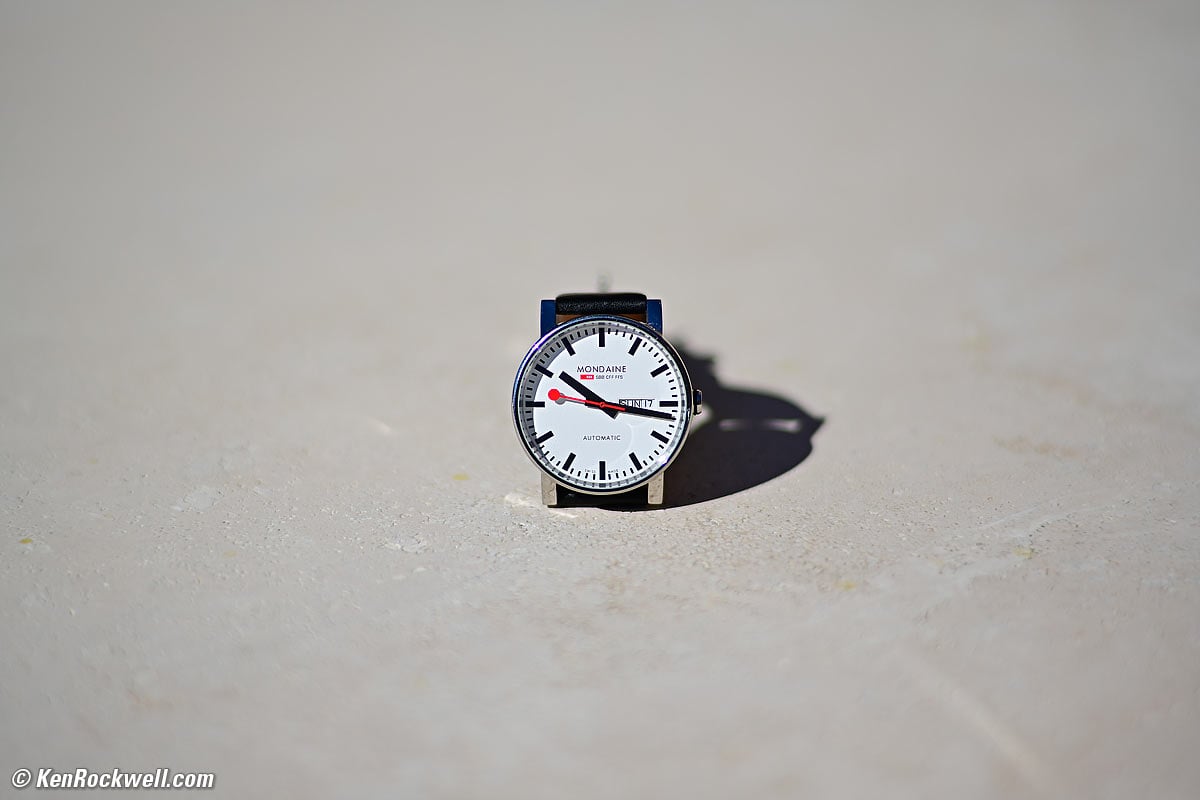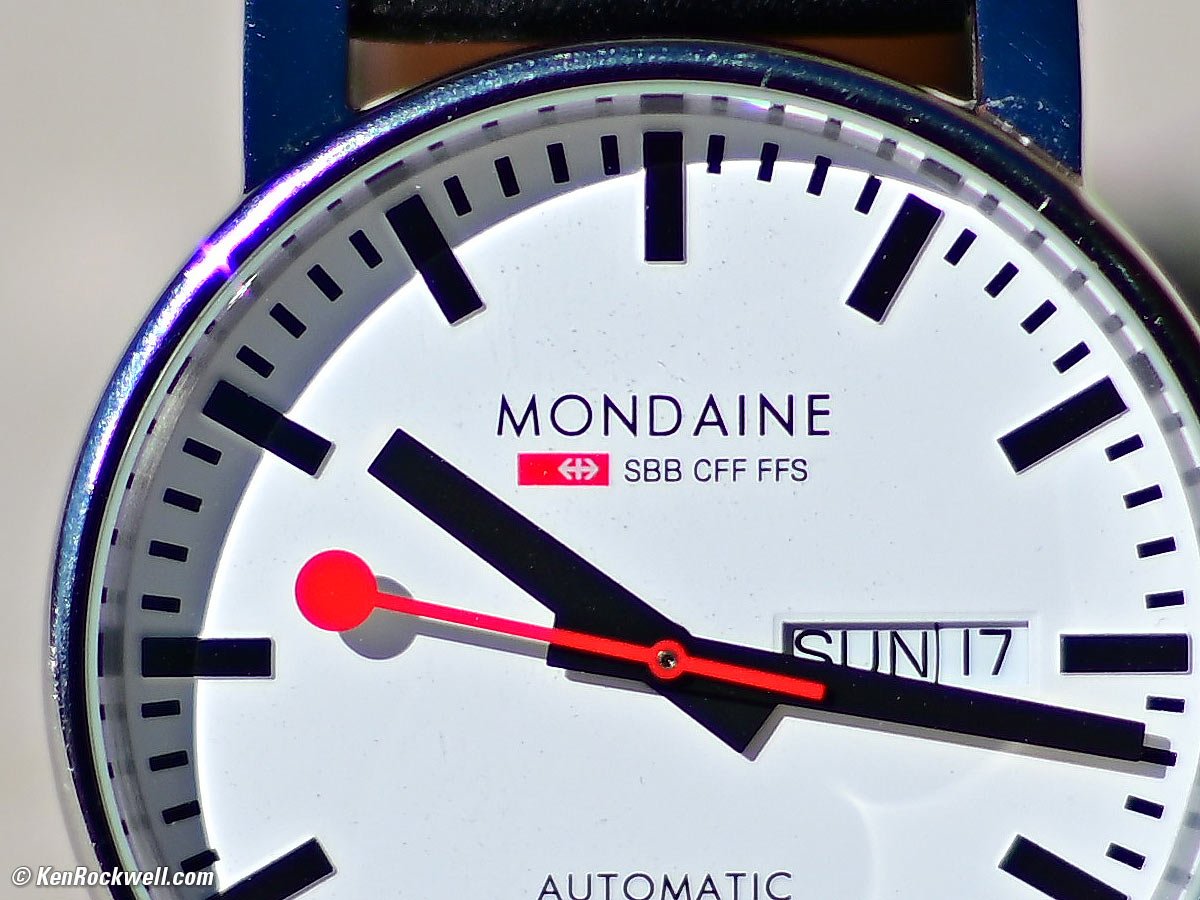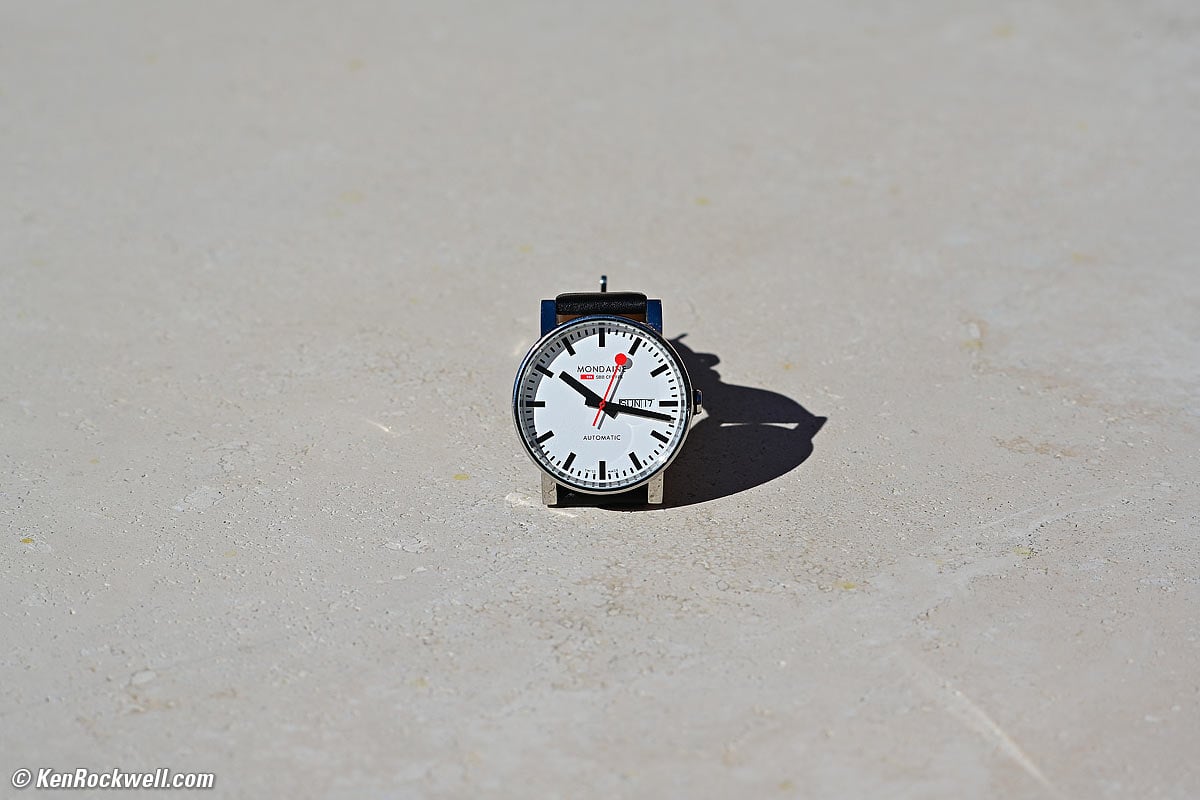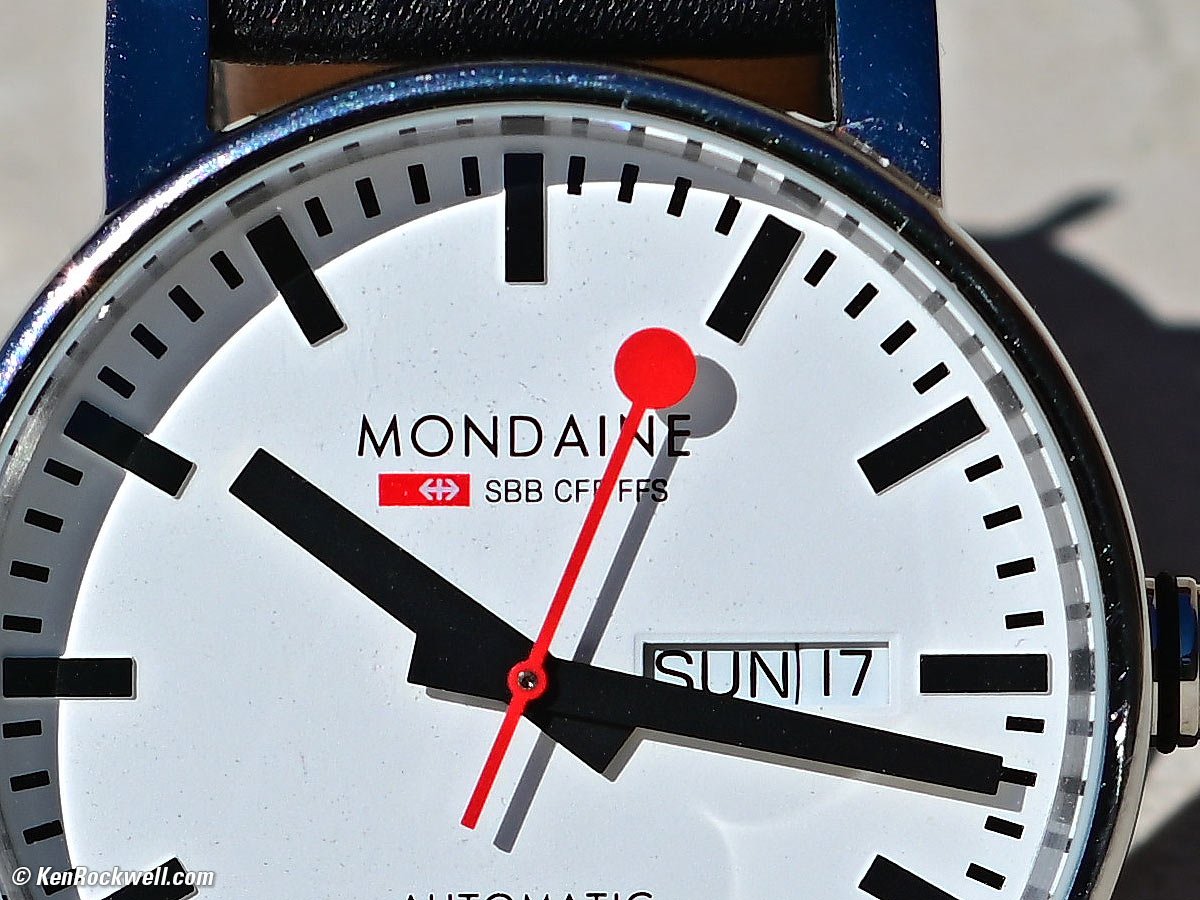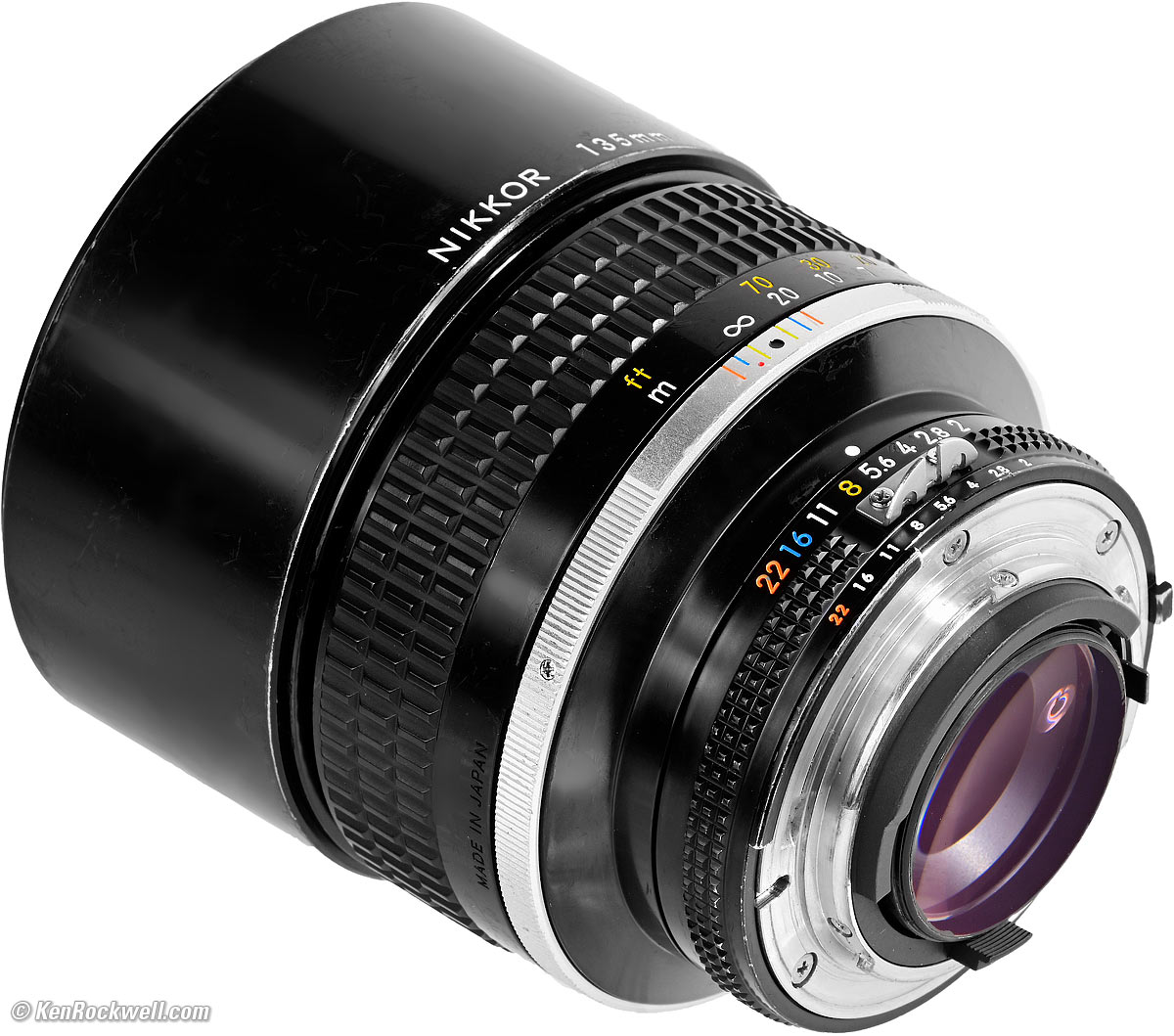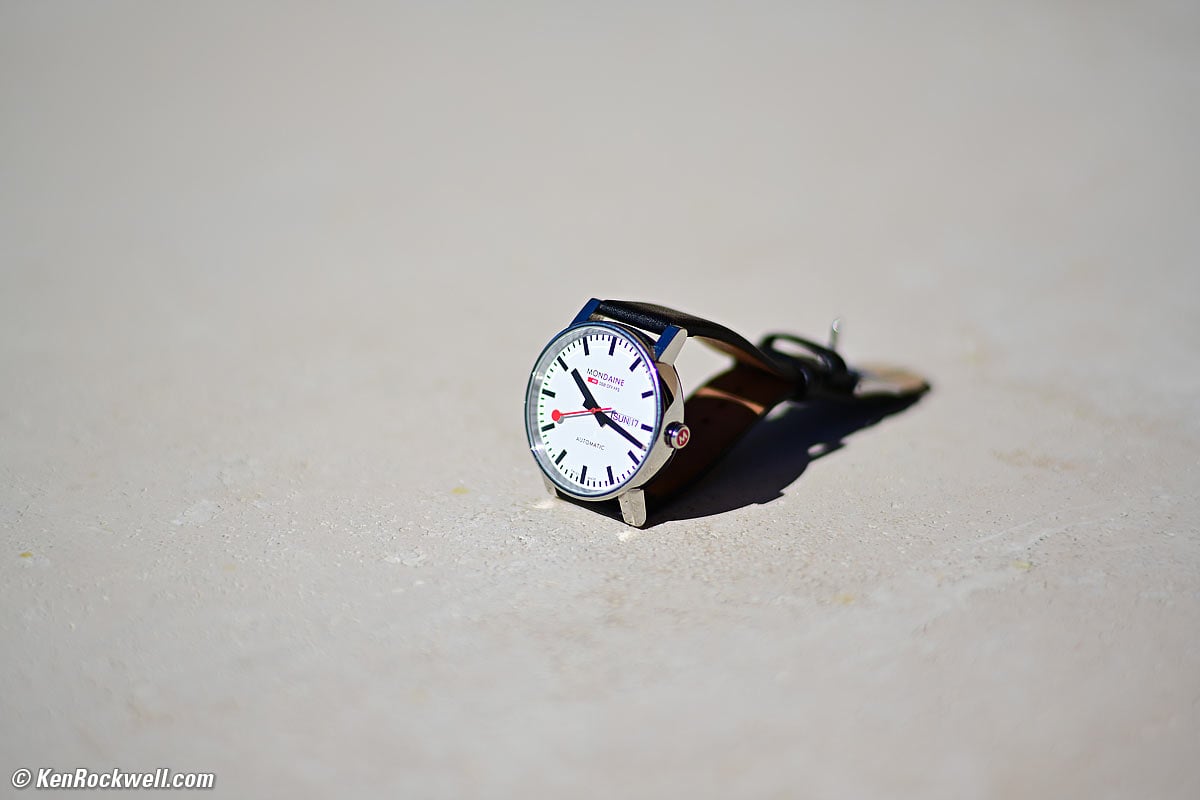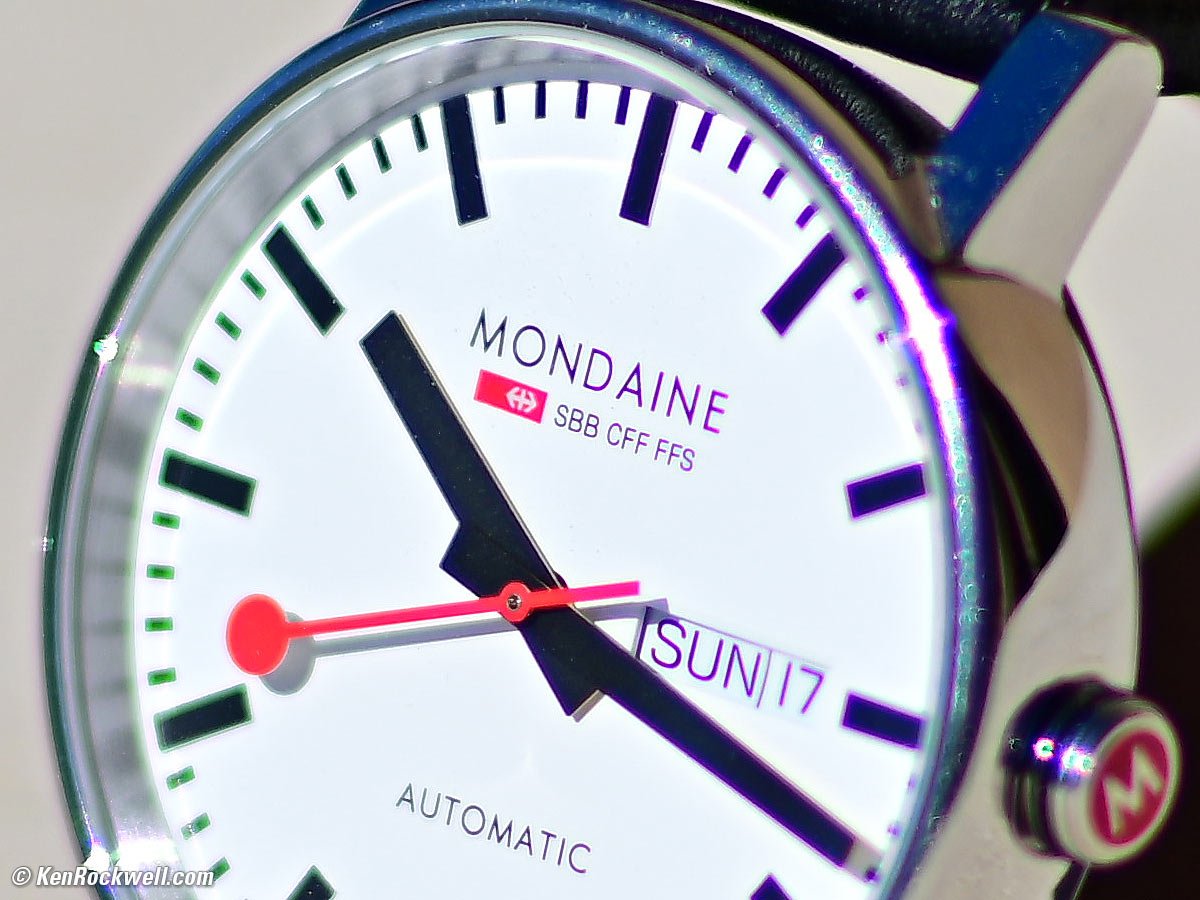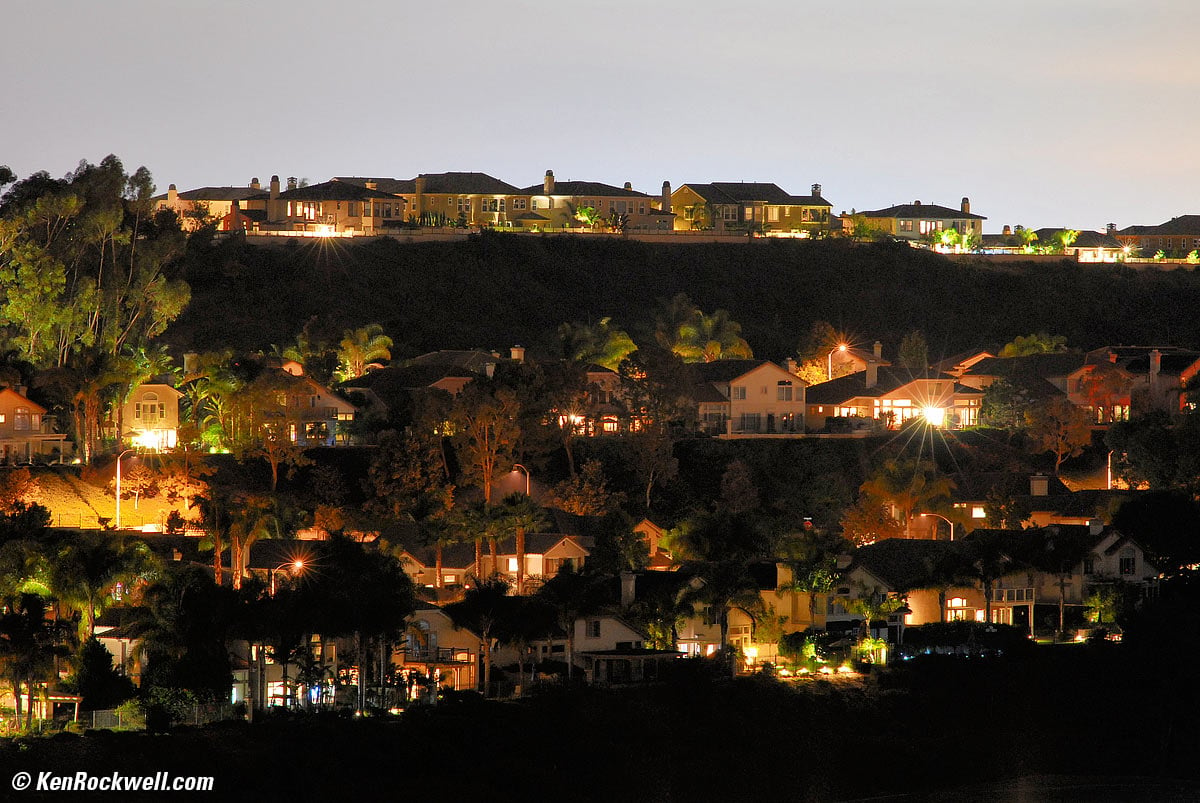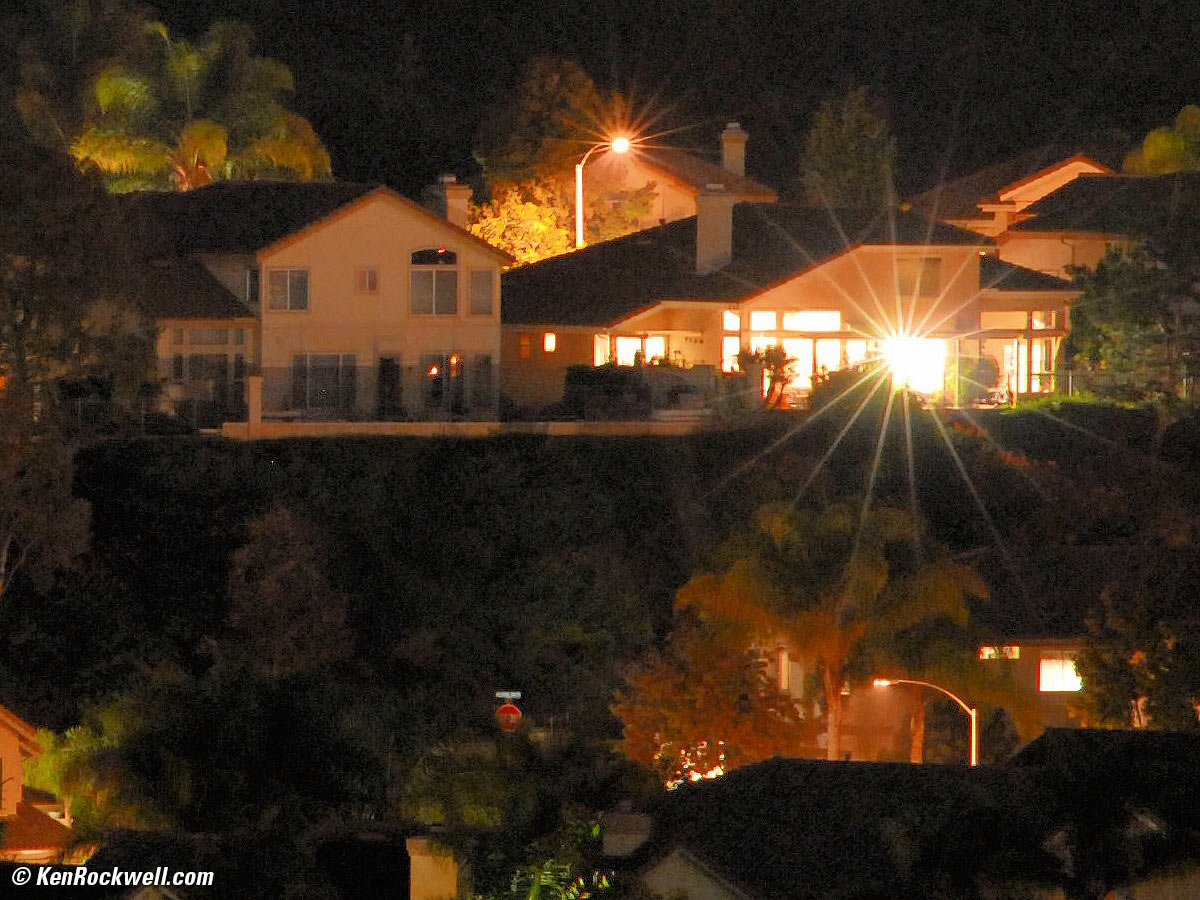Nikon 135mm f/2
NIKKOR, AI and AI-s (1975-2005)
Performance Compared Recommendations
Nikon NIKKOR 135mm f/2 AI-s (FX, DX and 35mm coverage, 72mm metal filter thread, built-in hood, 30.1 oz./854g, 4¼'/1.3m close-focus, about $350 used if you know How to Win at eBay). bigger.
My biggest source of support is when you use any of these links to approved sources, especially this link directly to them at eBay where I got mine, when you get anything, regardless of the country in which you live. Thanks for helping me help you! Ken.
Janaury 2024 Better Pictures Nikon Reviews Nikon Lenses Nikon Manual-Focus Lenses All Reviews
Why Fixed Lenses Take Better Pictures
Nikon Z 135mm f/1.8 (2023 - today)
Nikon AF-D 135mm f/2 DC (1990 - 2021)
Sample Images
Top Sample Images Intro Format
Performance Compared Recommendations
These are all shot hand-held as BASIC ★ JPGs; no RAW files, NORMAL or FINE JPGs were used or needed.
Wide-Open at f/2
Canary Palm, 9:19 AM, 17 March 2019. Nikon Z7, Nikon NIKKOR 135mm f/2 AI-s on FTZ adapter, f/2 at 1/320 at ISO 64, Perfectly Clear. bigger, full-resolution file or camera-original © 45MP file.
There's almost no depth of field at f/2; very little is in focus if you're going to explore the full-resolution file or camera-original © 45MP file at 100%. If you want to be impressed at this lens' sharpness wide-open, look at the ends of the palm fronds on the far right in the full-resolution file that are in focus and ultra-sharp. Very little else is in focus due to the shallow depth of field.
At f/8
Canary Palm, 9:19 AM, 17 March 2019. Nikon Z7, Nikon NIKKOR 135mm f/2 AI-s on FTZ adapter, f/8 at 1/80 at ISO 64, Perfectly Clear. bigger, full-resolution file or camera-original © 45MP file.
Introduction
Top Sample Images Intro Format
Performance Compared Recommendations
Versions & History New Good Bad Missing
|
I buy only from these approved sources. I can't vouch for ads below. |
The Nikon 135mm f/2 has been a professional secret for decades. Offering a long focal length, super f/2 speed and great optics in a compact, dense package, the 135/2 is longer and faster than just about anything else a reasonable person would wish to afford, or carry all day.
This 135/2 is about as big as a grapefruit, but much heavier. It's a compact lens that's all glass inside.
The 135mm f/2 is a superb portrait lens, especially for defocusing backgrounds. This 135mm f/2's bokeh is exemplary (really good), and it's also super sharp at every setting.
This 135mm f/2 has been one of Nikon's greatest portrait lenses ever since it was introduced in 1975. While the current 135mm f/2 DC (1990-today) adds autofocus and the ability to fine-tune bokeh and is sharper for scientific use at f/2, for portraits and general use this manual-focus lens has bokeh at least as good and costs far less to do the same thing.
On the FTZ adapter both this and the 135mm f/2 DC become manual focus, so why not save money and go with a proven classic? Even better, either of these 135mm f/2s add image stabilization (VR) when used on Nikon's full-frame mirrorless cameras.
Unlike the throw-away plastic lenses of today, this fully professional silky-smooth all-metal lens is built to last for more than a lifetime of spectacular images. Thankfully, today's 135mm f/2 DC is built almost as well.
I got my 135mm f/2 at this link to them at eBay (How to Win at eBay).
Versions & History
All of these lenses from 1975 ~ 2005 have the same optics.
Only the mechanics and cosmetics were changed as the years rolled on.
1975 ~ 1977
Nikon first sold this as the 135mm f/2 AUTO NIKKOR IC.
AUTO meant an automatic diaphragm that reopened back to f/2 after each shot. That was hot stuff in the 1960s, but taken for granted today.
IC meant Integrated Coating, which is multicoating.
This first version was not AI; one had to turn the aperture ring back and forth to get the camera's meter to couple to the lens each time it was mounted.
One needs AI kit 41 to update it to AI for use with Nikon's newest cameras.
1977 ~ 1981
Nikon updated this lens to AI, Automatic Indexing.
Now all we have to do is attach the lens and its aperture ring indexes with the meter automatically. It still works the same way on today's newest Nikon DSLRs.
1981 ~ 2005
Nikon updated this lens to AI-s, which is the same as AI, with the addition of a different diaphragm mechanism to make automatic exposure easier for the Nikon FA.
The AI-s version has its depth-of-field markings on the silver ring, has slightly faster manual focus gearing and has a slightly longer hood, otherwise, a 2005 AI-s sample is the same thing and works exactly the same as a 1975 model after it's been AI-converted.
Nikon USA stopped importing them in 1996, so from 1997-2005 they came into the USA only as gray market.
1990
Nikon introduces the 135mm f/2 DC, and continued to make this original 135mm f/2 for another 15 years alongside it!
The 135mm f/2 DC has completely different optics.
New
 World's first 135mm f/2 lens.
World's first 135mm f/2 lens.
 9-bladed diaphragm.
9-bladed diaphragm.
Good
 Fabulous bokeh.
Fabulous bokeh.
 Fast
Fast
 Compact.
Compact.
 Built-in hood.
Built-in hood.
 Straight 9-blade diaphragm for magnificent 18-pointed sunstars.
Straight 9-blade diaphragm for magnificent 18-pointed sunstars.
 Superlative mechanics: all metal, all engraved markings and no plastic.
Superlative mechanics: all metal, all engraved markings and no plastic.
 Heirloom-quality design and build to last beyond a lifetime.
Heirloom-quality design and build to last beyond a lifetime.
 Made domestically in Japan.
Made domestically in Japan.
Bad
 Nothing; this lens is from Nikon's golden era when they ruled the sports and news photography world.
Nothing; this lens is from Nikon's golden era when they ruled the sports and news photography world.
Missing
 Nothing at the time; autofocus and Vibration Reduction hadn't been invented yet.
Nothing at the time; autofocus and Vibration Reduction hadn't been invented yet.
 No plastic.
No plastic.
 No printing; every marking is deeply engraved and filled with paint to last a few lifetimes.
No printing; every marking is deeply engraved and filled with paint to last a few lifetimes.
 Not off shored to some second- or third-world country for cheap labor as Nikon usually does today; this is a precision-made masterpiece.
Not off shored to some second- or third-world country for cheap labor as Nikon usually does today; this is a precision-made masterpiece.
Format
Top Sample Images Intro Format
Performance Compared Recommendations
I got my 135mm f/2 at this link to them at eBay (How to Win at eBay).
This is a full frame FX lens, and I'm reviewing it as such.
It works great on DX cameras, too, on which you may make the usual inferences.
Compatibility
Top Sample Images Intro Format
Performance Compared Recommendations
I got my 135mm f/2 at this link to them at eBay (How to Win at eBay).
If you have one of the very early non-AI samples,(1975-1977, serial numbers below 180000), you'll need to have your lens AI-converted to work on cameras made since 1977. Even these oldest samples still work great on every Nikon made 1959-1977.
Presuming you have at least an AI or AI-converted sample, this manual-focus lens works great with most full-frame Nikon cameras made since 1977, both FX digital and 35mm. Of course it won't autofocus on any camera, but usually offers color matrix metering and aperture-preferred auto exposure if you like. It offers Aperture-priority, shutter-priority and full program auto exposure on the Nikon FA, and Matrix Metering on all FX cameras as well as the Nikon F4, Nikon FA and Nikon F6.
It also works great on better DX cameras, but won't meter with the cheapest DX cameras or cheaper autofocus 35mm cameras.
It works on the Z-series mirrorless cameras with the FTZ Adapter.
On all FX digital, Z-series mirrorless cameras, better DX cameras and the F6 be sure to set "135mm" and "f/2" at MENU > SETUP > NON-CPU LENS DATA, or wherever your camera hides the Non-CPU Lens Data option.
See Nikon Lens Compatibility for details on your camera. Read down the "AI, AI-s"column.
Specifications
Top Sample Images Intro Format
Performance Compared Recommendations
I got my 135mm f/2 at this link to them at eBay (How to Win at eBay).
Name
Nikon calls this the Nikon NIKKOR 135mm f/2 AI-s (1981-2005, shown here), AI (1977-1981) or AUTO-NIKKOR IC (1975-1977).
AUTO: Automatic diaphragm that closes for, and opens automatically after, each shot; high technology back in 1975.
NIKKOR: Nikon's brand name for all their lenses.
AI: Automatic (exposure meter) Indexing.
AI-s: Automatic (exposure meter) Indexing, with shutter-preferred optimized linear diaphragm actuation.
IC: Integrated (multi) coating.
Optics
Nikon NIKKOR 135mm f/2 Internal Optical Construction. bigger.
6 elements in 4 groups, an Ernostar variant configured by Yasushi MATSUI, who also designed the 180 mm f/2.8.
The Ernostar, designed in 1923 by Ludwig Jakob Bertele while working at H. Ernemann, was the world's first f/2 lens for still photography. The H. Ernemann company was eventually bought by Zeiss.
The highly asymmetrical and unit-focusing design of the Ernostar leads to more spherical aberration at close distances than symmetrical lenses like the Gauss variants. This is used to great advantage in the Nikon 135/2, as it's corrected for super-sharp images at far ranges, and the extra spherical aberration contributes to incredible bokeh at portrait distances.
It's multicoated, which Nikon calls IC (Integrated coating), and later Nikon Super Integrated Coating (SIC).
Unit focusing, the whole lens moves in and out on big helicoids.
Coverage
Diaphragm
Nikon NIKKOR 135mm f/2 AI-s at f/5.6. bigger.
9 straight blades.
Stops down to f/22 with full-stop clicks.
You may select any aperture anywhere between clicks.
Focal Length
135mm.
When used on DX cameras, it sees the same angle of view as a 200 mm lens sees when used on an FX or 35mm camera.
See also Crop Factor.
Angles of View
18º diagonal, 15º horizontal and 10º vertical on FX.
12º diagonal on DX.
Focus Scale
Yes, correctly color-coded in white for meters and in yellow for feet.
Infinity Focus Stop
Yes.
This is great for astronomy; just turn to the stop and you have fixed laboratory-perfect focus all night.
Depth of Field Scale
Nikon NIKKOR 135mm f/2 AI-s. bigger.
Yes, color-coded to the aperture values.
Reproduction Ratio Scale
No.
Infrared Focus Index
Yes: red dot in depth-of-field scale.
Close Focus
4¼ feet (1.3 meters).
NIKKOR and NIKKOR AI: 270º focus ring rotation.
IKKOR AI-s: 200º focus ring rotation.
Maximum Reproduction Ratio
1:7.5 (0.13×).
Filters
Solid aluminum alloy 72 mm filter thread.
Hood
Built-in Hood Extended, Nikon NIKKOR 135mm f/2 AI-s. bigger.
Built-in telescoping fuzzy black-flocked metal tubular hood.
Non-locking.
Hint: They always seem to get pushed back because they don't lock. Find a thick rubber band and put in on the barrel behind the hood and it will keep it extended.
Case
CL-15 Corinthian Leather tubular case, lined with Hungarian red velvet, and strap.
Size
3.2" diameter x 3.7" extension from flange (4.05" overall).
81mm diameter x 93.5mm extension from flange (103mm overall).
Weight
30.130 oz. (854.2 g), measured, AI-s version after service, 2019.
30.152 oz. (854.8 g), measured, AI-s version, 2011.
Nikon specifies 30.3 oz. (860 g) for all versions.
Quality
Made in Japan.
Serial Number Ranges
NIKKOR (not AI): 175,000 (1975) ~ 180,000 (1977). Nikon made about 5,000 of these.
NIKKOR AI: 190,000 (1977) ~ 198,000 (1981). Nikon made about 7,500 of these.
NIKKOR AI-s: 201,000 (1981) ~ 233,500 (2006). Nikon made about 33,000 of these.
Packaging
Gold-foil box, closed-cell white foam innards.
Price, USA
Janaury 2024 |
About $350 used if you know How to Win at eBay. |
May 2019 |
About $500 used if you know How to Win at eBay. |
August 2011 |
About $400 used if you know How to Win at eBay; for instance, I only paid $295 for this one in 2011. |
December, 1999 |
$699.95 new, gray market ($1,060 in 2019 dollars). (The 135/2 DC was $984.95 or $899.95 gray market.) |
December, 1998 |
$699.95 new ($1,100 in 2019 dollars). (The 135/2 DC was $984.95 or $849.95 gray market.) |
December, 1997 |
$799.95 new ($1,270 in 2019 dollars). (The 135/2 DC was $899.95 gray market.) |
December, 1996 |
$829.95 new ($1,340 in 2019 dollars). (The 135/2 DC was $949.95.) |
December, 1995 |
$849.95 new ($1,415 in 2019 dollars). (The 135/2 DC was $1,099.95.) |
December, 1994 |
$749.95 new ($1,280 in 2019 dollars). (The 135/2 DC was $909.) |
December, 1992 |
$619.95 new ($1,115 in 2019 dollars). (The new 135/2 DC was $819.95, or $1,475 in 2019 dollars.) |
December, 1991 |
$599.95 new ($1,111 in 2019 dollars). (The new 135/2 DC was $995.00, or $1,850 in 2019 dollars.) |
December, 1988 |
$599.00 new ($1,270 in 2019 dollars). |
January, 1987 |
$489.00 new ($1,125 in 2019 dollars). |
June, 1986 |
$409.95 new ($955 in 2019 dollars). |
January, 1983 |
$389 new ($1,015 in 2019 dollars). |
January, 1979 |
$519 new ($1,940 in 2019 dollars). |
June, 1977 |
$374.95 at Olden, NYC ($1,575 in 2019 dollars). |
New prices at full NYC discount at B&H Photo. Very few people bought their lenses this inexpensively back then.
** Gray market.
Performance
Top Sample Images Intro Format
Performance Compared Recommendations
Color Rendition Coma Distortion Durability
Ergonomics Falloff Filters Flare & Ghosts
Lateral Color Fringes Macro Mechanics
I got my 135mm f/2 at this link to them at eBay (How to Win at eBay).
Overall
The 135mm f/2 AI-s is a marvelously precise hunk of professional precision.
Its optics are superb, and its Bokeh is particularly extraordinary.
It has some spherochromatism and spherical aberration that improve bokeh, but demand precise focus to avoid colored fringes if you're a window-screen photographer.
The 135.2 AI-s is an extraordinary portrait lens.
Focus
Manual focus is flawless.
Manual focus as smooth as silk, perfectly damped and with no play.
The entire lens moves in and out on a big, precise brass and aluminum helicoid.
Just two fingertips or one firm fingertip is all it takes to focus this lens, even pointed straight up or down.
Focus is ultra smooth and only lightly damped. If yours is stiff, gritty or uneven, your lens is broken and needs service.
Better AF and digital Nikons have three very precise electronic manual focus indicators, with which this lens works perfectly.
Lesser digital cameras usually have just one "OK" focus dot, which is not as precise as two arrows and a dot.
This will vary from sample-to-sample of camera and from sample-to-sample of lens, and my sample focused perfectly to just a tad close at f/2.
Focus is critical for the sharpest results at f/2. If you're not getting the results you expect, it's probably a lack of perfect focus on your part, not the lens.
Magnified Live View will always be the most accurate and precise.
Focus Breathing
Focus breathing is the image changing size as focused in and out. It's important to cinematographers that the image not breathe because it looks funny if the image changes size as focus gets pulled back and forth between actors. If the lens does this, the image "breathes" by growing and contracting slightly as the dialog goes back and forth.
As a unit-focus lens whose entire optical cell moves in and out together, the image from this 135/2 gets larger as focused more closely.
Bokeh
Bokeh, the feel, character or quality of out-of-focus areas as opposed to how far out of focus they are, is excellent at f/2, as well as at smaller apertures.
Even at smaller apertures like f/5.6, edges of out-of-focus highlights fade smoothly, letting backgrounds melt away.
As always, if you want to throw the background as far out of focus as possible, shoot at f/2 and get as close as possible.
Here are photos of my Davis 6250 weather station on 21 May 2019 from headshot distance, which was about 7.5 feet (2.3 meters) in these photos.
Click any for the Nikon Z7-original 45 MP files:
Click any of the above for the camera-original 45 MP Nikon Z7 image.
Here are full-frame FX images focused on a reference phase lattice at 3 meters (10 feet) with synthetic reference vegetation at 15 meters (50 feet). This is about the distance at which you'd shoot head-and-shoulder portraits.
Color Rendition
Color rendition is neutral, matching my other multicoated NIKKOR lenses from the 1970s through today.
Coma
Coma, or sagittal coma flare, is often seen with fast normal to wide lenses as weird batwing shapes on bright points of light in the corners at night.
I don't see any coma in this lens, which usually affects wide, not tele lenses.
Distortion
The Nikon 135mm f/2 AI-s has no visible distortion.
For scientific or other more critical uses, what invisible pincushion distortion remains can be corrected fully by plugging these figures into Photoshop's lens distortion filter. These aren't facts or specifications, they are the results of my research that requires hours of photography and calculations on the resulting data.
FX and Film |
||
∞ |
-1.1 |
-0.5 |
10' (3m) |
-0.8 |
-0.5 |
© 2011 KenRockwell.com. All rights reserved.
Durability
Unlike the plastic rubbish that Nikon offshores today, this is a thoroughly professional lens built to last several lifetimes.
All the other product photos throughout this review took a lot of makeup and Photoshop to look presentable. Here is an unretouched photo of how my lens actually looks:
Nikon NIKKOR 135mm f/2 AI-s. bigger.
Mine is in this shape and still cranks out great images.
I had Gus Lazzari service my lens; its focus had become very stiff.
Take better care of your lenses and these manual-focus Nikon lenses are usually good for at least 50 years between overhauls, which is a lot better than LEICA's lenses which usually get sticky and cloudy well before that.
Ergonomics
Nikon NIKKOR 135mm f/2 AI-s. bigger.
The big, beautiful focus ring is covered in Nikon's signature flat-topped pyramidal "iron block" rubbery grip material. Unlike the crappy imitation rubber Nikon has used since around year 2000 on autofocus lenses that gets sticky after about 12 years, this rubber stays just like new forever.
Just one moderately firm fingertip is all it takes to focus this lens, even pointed straight up or down.
The silver ring is the mounting grip. Grab this to mount and unmount the lens. It's easy to see or feel in any light.
The solid cast-alloy aperture ring is easy to set with a single fingertip. It's easy to set to any intermediate aperture, and has full-stop clicks. Pros set their apertures by feel, counting clicks up or down from f/22 or f/2.
My only whine is that the hood has no lock, and keeps getting pushed-in with use.
Falloff
Falloff on FX and 35mm is minor at f/2, and goes away by f/2.8. It's very nice at f/2 when used for a subtle highlighting effect.
It won't be an issue at all on DX (see crop factor).
I've greatly exaggerated the falloff by shooting a gray field and placing these on a gray background; it will not look this bad in actual photos of real things:
Nikon 135mm f/2 AI-s falloff on FX and 35mm at infinity, correction turned OFF.
© 2019 KenRockwell.com. All rights reserved. |
Filters, use with
There is no problem with vignetting, even with combinations of thick filters.
This is typical for long lenses.
Go ahead and use your standard rotating polarizer and grad filters.
Flare & Ghosts
This lens uses a simple optical formula and has no problem with flare or ghosts.
Lateral Color Fringes
There are no lateral color fringes as shot on Nikon cameras, which by default correct for any that may be there.
There is plenty of spherochromatism, which can cause color fringes on things that aren't in perfect focus. Spherochromatism is a completely different aberration in a different dimension than lateral color fringes.
Macro Performance
It gets as close as most manual-focus lenses, whch isn't very close, but it remains very sharp even at f/2, which is excellent performance.
Wide-open at f/2
It's surprisingly sharp and contrasty wide-open at f/2:
Mondaine A132.30348.11SBB at close-focus distance at f/2, 17 March 2019. bigger or Nikon Z7-original © 45MP file.
1,200 × 900 pixel crop from above. bigger or Nikon Z7-original © 45MP file.
The magenta sparkle at the top left is spherochromatism, because the top of the case isn't in perfect focus.
The dirt specks you're seeing are on the watch face and crystal.
If this 1,200 × 900 pixel crop is about 3" (7.5cm) wide on your screen, the complete image would print at a large 14″ × 21″ (35 × 55 cm) at this same high magnification.
If this 1,200 × 900 pixel crop is about 6" (15cm) wide on your screen, the complete image would print at a huge 27½″ × 41¼″ (70 × 105 cm) at this same high magnification.
If this 1,200 × 900 pixel crop is about 12" (30cm) wide on your screen, the complete image would print at a mammoth 55 × 82½″ (1.4 × 2.1 meters) at this same extremely high magnification!
At f/8
By f/8 it's ultrasharp and the spherochromatism is long gone:
Mondaine A132.30348.11SBB at close-focus distance at f/8, 17 March 2019. bigger or Nikon Z7-original © 45MP file.
1,200 × 900 pixel crop from above. bigger or Nikon Z7-original © 45MP file.
The dirt specks you're seeing are on the watch face and crystal.
If this 1,200 × 900 pixel crop is about 3" (7.5cm) wide on your screen, the complete image would print at a large 14″ × 21″ (35 × 55 cm) at this same high magnification.
If this 1,200 × 900 pixel crop is about 6" (15cm) wide on your screen, the complete image would print at a huge 27½″ × 41¼″ (70 × 105 cm) at this same high magnification.
If this 1,200 × 900 pixel crop is about 12" (30cm) wide on your screen, the complete image would print at a mammoth 55 × 82½″ (1.4 × 2.1 meters) at this same extremely high magnification!
Mechanical Quality
Nikon NIKKOR 135mm f/2 AI-s. bigger.
This is one of Nikon's finest lenses of all time. It is made to even better standards than LEICA's lenses because Nikon uses even longer-life lubricants good for about 40-50 years and that don't cloud the glass, rather than the 15- to 20- years over which LEICA's lubricants work and thereafter cloud the glass.
Finish
Semi-matte black enamel over black-anodized aluminum.
Hood
Solid alloy.
Flocked interior.
Non-locking.
Front Bumper
None.
Filter Threads
Solid alloy.
Barrels
Metal.
Focus Ring
Rubber-covered solid alloy.
Focus Helicoids
Brass and aluminum: smooth and silky with no play or need for damping grease.
Rear Barrel
Metal.
Identity
Engraved into the very living metal and filled with paint around the back of the telescoping hood.
Internals
All metal!
Dust Gasket at Mount
No.
Mount
Dull chromed metal.
Markings
All engraved and filled with paint.
Serial Number
Engraved and filled with paint around the back of the telescoping hood.
Date Code
None found, use your algebra and your serial number.
Noises When Shaken
Mild clicking from the diaphragm blades and their actuation system.
Made in
Japan.
Sharpness
Lens sharpness has nothing to do with picture sharpness; every lens made in the past 100 years is more than sharp enough to make super-sharp pictures if you know what you're doing. The only limitation to picture sharpness is your skill as a photographer. It's the least talented who spend the most time worrying about lens sharpness and blame crummy pictures on their equipment rather than themselves. Skilled photographers make great images with whatever camera is in their hands; I've made some of my best images of all time with an irreparably broken camera! Most pixels are thrown away before you see them, but camera makers don't want you to know that.
If you're not getting ultra-sharp pictures with this, be sure not to shoot at f/11 or smaller where all lenses are softer due to diffraction, always shoot at ISO 100 or less because cameras become softer at ISO 200 and above, avoid shooting across long distances over land which can lead to atmospheric heat shimmer, be sure everything is in perfect focus, set your camera's sharpening as you want it (I set mine to the maximum) and be sure nothing is moving, either camera or subject. If you want to ensure a soft image with any lens, shoot at f/22 at ISO 1,600 at default sharpening in daylight through heat shimmer of rapidly moving subjects at differing distances in the same image.
With those caveats, the 135mm f/2 AI-s is very sharp even at f/2, but you have to be in perfect focus to see it.
Be sure you're in perfect focus, as even the slightest lack of perfect focus may lead to you seeing green or magenta color fringes caused by spherochromatism. If you see these, try refocusing with magnified live view, or stop down a little to f/2.8 or f/4 and spherochromatism goes away.
If your images aren't sharp or have color fringes, it's because they aren't in perfect focus. Focus is critical with such a long, sharp lens. This lens looks great even on Nikon's newest state-of-the-art 50MP cameras, but at f/2 you have to focus very carefully with magnified live view.
Focus is critical with such a long, sharp lens.
Spherochromatism
Spherochromatism, also called "color bokeh" by laymen, is an advanced form of chromatic aberration in a different dimension than lateral color. It can cause colored fringes on out-of-focus highlights, usually seen as green fringes on backgrounds and magenta fringes on foregrounds. Spherochromatism is common in fast lenses of moderate focal length when shooting contrasty items at full aperture. It goes away as stopped down.
This 135/2, as a very fast telephoto without ED glass, has loads of spherochromatism at f/2. It has much less at f/2,8 and it's gone by f/4.
This helps the bokeh, since background highlights are often green vegetation, which spherochromatism blurs even more!
Mondaine A132.30348.11SBB at close-focus distance at f/2, 17 March 2019. bigger or Nikon Z7-original © 45MP file.
1,200 × 900 pixel crop from above. bigger or Nikon Z7-original © 45MP file.
If this 1,200 × 900 pixel crop is about 3" (7.5cm) wide on your screen, the complete image would print at a large 14″ × 21″ (35 × 55 cm) at this same high magnification.
If this 1,200 × 900 pixel crop is about 6" (15cm) wide on your screen, the complete image would print at a huge 27½″ × 41¼″ (70 × 105 cm) at this same high magnification.
If this 1,200 × 900 pixel crop is about 12" (30cm) wide on your screen, the complete image would print at a mammoth 55 × 82½″ (1.4 × 2.1 meters) at this same extremely high magnification!
Sunstars
With its straight 9-bladed diaphragm, the 135mm f/2 makes magnificent 18-pointed sunstars on bright points of light at almost all apertures:
Nikon 135mm f/2 at f/5.6 and 30 seconds, ISO 500, cropped from Nikon D200, Aviara, 13 October 2007. bigger.
1,200 x 900 pixel crop from above. bigger.
Teleconverters
As a fast telephoto, the 135/2 works very well with most teleconverters that fit, which are the TC-1, TC-200, TC-201, TC-14A, TC-16 (only for the rare F3AF) and TC-16A autofocusing teleconverter.
The TC-2, TC-300, TC-301, TC-14, TC-14B won't fit because they need to poke into the back of a lens.
None of the TC-E converters fit as their mounts are machined to ensure that they only attach to AF-S lenses.
Nikon warns that at f/11 and smaller there can be uneven exposure at high shutter speeds.
The TC-200, TC-201 and TC-14A are the most common.
Compared
Top Sample Images Intro Format
Performance Compared Recommendations
I got my 135mm f/2 at this link to them at eBay (How to Win at eBay).
See Bokeh compared to the Nikon Z 135mm f/1.8 and Compared to the Nikon Z 135mm f/1.8.
Compared to the Nikon 135mm f/2 DC
The Nikon 135mm f/2 DC is sharper at f/2; this original 135mm f/2 is slightly softer than the 135/2 DC at f/2, and just as sharp stopped down. Bokeh is about the same between the two.
The Nikon 135mm f/2 DC has a rounded diaphragm, so it doesn't make sunstars as well as this lens.
The built-in telescoping hood of the 135mm f/2 DC screw-locks in place, while the same hood on the manual-focus lenses won't lock in place, so it slips back in use.
The Nikon 135mm f/2 DC is a traditional screw-focus autofocus lens, which most people will prefer over manual-focus only.
The Nikon 135mm f/2 DC weighs a little bit less (818g versus 855g) and takes the same 72mm filters.
The Nikon 135mm f/2 DC focuses slightly closer (1.1 versus 1.3 meters).
Thankfully, today's 135mm f/2 DC is built just as well.
A Nikon 135mm f/2 DC costs three times as much, used or new.
Compared to the slower Nikon 135mm manual-focus lenses
The Nikon 135mm f/2.8 AI-s and Nikon 135mm f/3.5 AI have the same optical performance at the same f/stops. The only difference is the ability to open to larger apertures or not, with the attendant loss in quality.
In other words, at f/4, all three lenses (this f/2, the f/2.8 and f/3.5) all perform the same.
The only reason to pay more for a faster version is to be able to use the faster f/stop.
If you're shooting at f/3.5 or smaller, all three lenses are optically indistinguishable, and all you've accomplished with the faster lens is paying more for it, and more weight to carry.
If sunstars are your thing, this f/2 has a magnificent 9-bladed diaphragm, while the f/2.8 and f/3.5 only have 7 blades.
This 135/2 uses a much larger 72mm filter, while the f/2.8 and f/3.5 versions take standard 52mm filters.
Of course if you want spectacular defocus effects and are shooting at f/2, the slower lenses can't shoot at f/2. Even the 135mm f/3.5 will defocus the background fa more than a 50mm lens, while the f/2.8 and f/2 will do it a little bit more. If money is tight, the slower 135mm lenses are still wonderful, while the f/2 is fantastic for bokeh.
Recommendations
Top Sample Images Intro Format
Performance Compared Recommendations
I got my 135mm f/2 at this link to them at eBay (How to Win at eBay).
The Nikon 135mm f/2 AI-s is a solid manual-focus professional portrait lens, with excellent performance for just about every use.
It's inexpensive to buy used, and will last more than a lifetime.
The Nikon 135mm f/2 DC is also a spectacular lens, but if you don't mind turning the focus ring for yourself, this classic 135/2 can save you $1,000.
Get a new pinch-type 72mm Nikon front cap. The flatter originals never were as handy.
I use a clear (UV) protective filter instead of a cap so I'm always ready to shoot instantly. I only use a cap when I throw this in a bag with other gear without padding — which is never. The UV filter never gets in the way, and never gets lost, either.
The very best protective filter is the 72mm Hoya multicoated HD3 UV which uses hardened glass and repels dirt and fingerprints.
For less money, the B+W 72mm 010 is an excellent filter, as are the multicoated version and the basic multicoated Hoya filters, but the Hoya HD3 is the toughest and the best. Nikon's 72mm Clear filter is also optically excellent.
Filters last a lifetime, so you may as well get the best. The Hoya HD3 stays cleaner than the others since it repels oil and dirt and is less likely to break if hit.
For color slides like Velvia 50, I use a 72mm Nikon A2 filter outdoors.
For B&W film outdoors, I'd use a 72mm Hoya HMC Yellow K2.
This 100% all-content website's biggest source of support is when you use this link to them at eBay or any of these links to approved sources when you get anything, regardless of the country in which you live. I use the stores I do because they ship from secure remote warehouses where no one gets to touch your new camera before you do. Buy only from the approved sources I use myself for the best prices, service, return policies and selection.
Thanks for helping me help you!
Ken, Mrs. Rockwell, Ryan and Katie.
© Ken Rockwell. All rights reserved. Tous droits réservés. Alle Rechte vorbehalten.
Help Me Help You
I support my growing family through this website, as crazy as it might seem.
The biggest help is when you use any of these links when you get anything. It costs you nothing, and is this site's, and thus my family's, biggest source of support. These places always have the best prices and service, which is why I've used them since before this website existed. I recommend them all personally.
If you find this page as helpful as a book you might have had to buy or a workshop you may have had to take, feel free to help me continue helping everyone.
If you've gotten your gear through one of my links or helped otherwise, you're family. It's great people like you who allow me to keep adding to this site full-time. Thanks!
If you haven't helped yet, please do, and consider helping me with a gift of $5.00.
As this page is copyrighted and formally registered, it is unlawful to make copies, especially in the form of printouts for personal use. If you wish to make a printout for personal use, you are granted one-time permission only if you PayPal me $5.00 per printout or part thereof. Thank you!
Thanks for reading!
Mr. & Mrs. Ken Rockwell, Ryan and Katie.
